Fantasy Books
Teaser Tuesdays - The Unseelie Throne
 “You…you know?”“Not in as many words. He has not said it to me.” She broke off a piece of bread on her plate and fiddled with it idly.
“You…you know?”“Not in as many words. He has not said it to me.” She broke off a piece of bread on her plate and fiddled with it idly.(page 99, The Unseelie Throne by Kathryn Ann Kingsley)
---------
Teaser Tuesdays is a weekly bookish meme, previously hosted by MizB of Should Be Reading. Anyone can play along! Just do the following: - Grab your current read - Open to a random page - Share two (2) “teaser” sentences from somewhere on that page BE CAREFUL NOT TO INCLUDE SPOILERS! (make sure that what you share doesn’t give too much away! You don’t want to ruin the book for others!) - Share the title & author, too, so that other TT participants can add the book to their TBR Lists if they like your teasers!
In Defence of Purple Prose
 Image by Gerd Altmann from Pixabay
Image by Gerd Altmann from Pixabay
Good afterevenmorn, Readers!
Language is fun. The way words can mean more than one thing, depending on where the stress is placed, or its location in a sentence, and where that sentence lies within the tale. It is a playground. A song devising its own music. A melody murmured that can delight not just the eyes, but the ears. How many have paused a read simply to revel in the words just read? To read and reread a sentence? To bask in the brilliance of a cleverly turned phrase?
 Image by Лариса Мозговая from Pixabay
Image by Лариса Мозговая from Pixabay
Yet so many decry the joy in that play. Brevity, they proclaim, is king. Only he shall rule the pages, painted words slinking away beneath his stern gaze. That is good writing. The only good writing.
In truth, he is but a soldier, which, like his fellows, when craftily deployed becomes a part of a larger song. The short notes like bombs, delivered with precision to inspire fear, or awe. To drag at the breath, stealing it away. To raise the pulse; a rapid fire of words – rat-tattat-tat!
Ah! But the exhaustion of battle needs reprieve. Across the trenched-scarred fields where fearful clouds of pale green gas linger still, hugging the ground as a jealous devotee, there must be some tenderness. Some beauty. Some gentle caress that reveals a painted sky, a lone flower refusing to bow before the fire, to linger ever so longingly on a lover’s heart.

These, too, deserve their time to shine. To dance in the light. Frivolous! come the cries. Pointless! Indulgent! Foolish! What purpose could frills and silks fill that isn’t achieved with more utilitarian cloth?
Beauty, my loves. Beauty is the point. To paint with words. To make poetry of prose. To fill the pages with images that transcend description. To make the words felt instead of merely read. To revel in the wonder of words, and the music they can make if we indulge them ever so slightly. For, before they were written, they were said; every syllable deliberately placed to please, to create a rhythm, to dance with the flames beside which they were uttered.
There is no crime in returning to that fire, though the words reach an audience of naught but one. In reclaiming that dance. In revealing the beauty of words and the myriad of ways they can be put together.

Play, my dears. Play is the point. What fun to toy with meaning and expectation, to weave and weft! To delight in triplets trickling from tickled tongues. To find the fun; to splash in the sun-dappled stream of language and chase the meanings swimming lazily beneath the surface. For language can be such a joy if we let it, if we break free from the tyranny of Brevity for its own sake.
There is no sin in letting the words play. In delighting at their twisting, joyous clamour. To dance with them their strange magical rites.

So many tangled tales have been met with distaste from one, only to be adored by another. Many a phrase has stopped an artist in their tracks, struck by the beauty, only to be scorned by the scholar.
In truth, there is no proper way to present prose. Dance or do not. Play or do not. Let the tyrant Brevity reign over the page, or place him back down into the ranks to work in concert with his fellows, or abandon him altogether. It is all correct. It is all true. It is all right.
But turn not away from the colour purple because some fool said you must. Like Brevity, it has its place and its purpose, even if that purpose is simply to be frivolous, existing for nothing else but the music it makes.
Or maybe even to inflate a word count. Ahem.
Alright, I’m done playing now. Mostly. Though I’ve been terribly tongue-in-cheek with this post, the sentiment is true. I do love reading books where the author has permitted themselves to revel in the language they use; when it’s clear that they’re going not for strict adherence to the rules and order, but to create an image, to paint, to evoke an emotion.
Yes, learn the rules. Of course.
And then smash them to pieces.
Is it possible to mess it up? Yes. Perhaps it doesn’t quite work. But that’s the wonderful thing about words. They’re much like painting in oils. You can massage the colours, work them across the canvas until they form the pleasing shapes you were aiming for. Or simply scrape teh canvas clean and start again. But don’t be so afraid of messing it up that you never attempt to paint at all. Take the time to play with words. Have fun.
Know that there will be a reader who will love your “purple” prose. It will likely be me, since I love how wonderful and musical language can be.
What about you? What writing styles do you like? There are no wrong answers in this case, only differing opinions. And I love hearing them!
When S.M. Carrière isn’t brutally killing your favorite characters, she spends her time teaching martial arts, live streaming video games, and cuddling her cat. In other words, she spends her time teaching others to kill, streaming her digital kills, and a cuddling furry murderer. Her most recent titles include Daughters of Britain, Skylark and Human. Her serial The New Haven Incident is free and goes up every Friday on her blog.
SPFBO Finalist Interview: Rachel Aaron, the author of By A Silver Thread

ABOUT THE AUTHOR: Rachel Aaron lives in Colorado with her family. She has graduated from University of Georgia with a B.A. in English Literature. She has been an avid reader since her childhood and now has an ever-growing collection to show for it. She loves gaming, Manga comics & reality TV police shows. She also posts regularly on her blog about publishing, books and several other intriguing things.
Find Rachel online: website
By a Silver Thread links: Amazon, Goodreads
Thank you for agreeing to this interview. Before we start, tell us a little about yourself.
Absolutely! I’m Rachel Aaron for most of my titles, but I also write Science Fiction under Rachel Bach. I got my start as a writer with my debut Fantasy novel, The Spirit Thief, published by Orbit Books in 2010. It’s a fun, fast paced romp about a wizard thief and it’s still one of my favorite stories I’ve ever written. After eight books with Orbit, I decided to try my hand at self publishing with my cyberpunk/Urban Fantasy mashup novel Nice Dragons Finish Last about dragons in a futuristic magical Detroit. It was an amazing experience and I’ve been self publishing ever since!
Do you have a day job? If so, what is it?
Nope, I’ve been writing full time since 2012. I keep waiting for the day I have to get a real job again, but so far so good!
Who are some of your favorite writers, and why is their work important to you?
If we’re talking about authors that heavily influenced me as a writer, it’s gotta be the books I stole from my mom’s bookshelf. We’re talking Peter S. Beagle, C.S. Lewis, Ursula LeGuin, Elizabeth Moon, Marion Zimmer Bradley, and of course Tolkien. (My mom is a giant LOTR fan). More recently, I’ve absolutely fallen in love with T. Kingfisher and Naomi Novik. Those ladies write some beautiful books!
What do you like most about the act of writing?
The pure joy of creation. I call myself a method actor writer because I get totally swept up in my stories. That feeling of being in a different world where I get to be god is the reason I do this. I’m one of those writers who can’t help but write. Even if no one wanted to read my stuff, I’d still have to write it because I can’t not write. At this point, I’m pretty sure I’m going to be doing this until I die.
Can you lead us through your creative process? What works and doesn’t work for you? How long do you need to finish a book?
You’re not going to like this answer, but it really is different for every story. I’ve written first drafts in as little as 13 days and as long as 16 months. Every story is its own unique world of problems. Sometimes I know exactly what I’m doing and the whole thing comes out right on the first try. Other times I have to keep failing forward until I flop over the finish line by dint of sheer determination. I always make a plan, but no plan survives the first encounter with the enemy, so I just do my best and keep bashing my way forward until the book is good. (It HAS to be good. Rule #1 of publishing: books can be late for six months but they’re bad forever. NEVER put out something you’re not proud of to meet a deadline.)
What made you decide to self-publish By A Silver Thread as opposed to traditional publishing?
It’s kind of mercenary, but the money. I loved working with Orbit Books, but I’ve got a family to support and self publishing pays authors way better than publishing contracts do. I’m also a control freak who loves handling her own business and marketing decisions, so it was a natural fit for me. I also like that I can make my titles cheaper for readers while still earning a decent living. I know I hate paying $13.99 for an ebook, and making sure my books are never in that position is a big part of why I publish independently.
What’s your favorite and least favorite parts of self-publishing?
Favorite: having total control. Least favorite: having total control.
Every screw up is my fault and there’s no one else to do the work. There’s a lot of days when I hate having to wear every hat, but I also love it when I get to pick exactly the right cover I want for the title. It all balances out!
Why did you enter SPFBO?
Because Mihir at Fantasy Book Critic told me to! He’s been reviewing my books since the very beginning. He’s amazing and always knows what’s cool. I’ve never gone wrong taking his advice, and since I’m here in the finals, I’d say his streak has held true. Thank you, Mihir, for encouraging me to enter!!
How would you describe the plot of By A Silver Thread if you had to do so in just one or two sentences?
A fairy changeling must break free of her abusive father figure and use her shapeshifting magic and knowledge of the dangerous fairy courts to save her lost sister in a magical future version of Detroit.
What was your initial inspiration for By A Silver Thread? How long have you been working on it? Has it evolved from its original idea?
I actually came up with Lola’s story long before the DFZ was a thing. I actually wrote the first version of her book back when I was still working on my Orbit titles, but I could never get the story to work and eventually abandoned the project. Then, over a decade later, I was brainstorming up new ideas for the DFZ when I realized I hadn’t written a story about a blood mage yet. The idea was first mentioned by Marci in Nice Dragons Finish Last, but I’d never gotten a chance to do anything with it. Since I’d originally stolen the idea from Victor in that abandoned novel, though, this got me thinking about Lola again and the whole series just snapped together like it was meant to be!
This is why you never throw away old novels. You never know when those words will come back to be useful!
What genre does it belong to?
Definitely Urban Fantasy, but the genre has been so invaded by Paranormal Romance that most people get confused when I tell them I don’t write about werewolves and vampires. It really is an Urban Fantasy, though, because there’s dragons and the city itself is a speaking character.
If you had to describe it in 3 adjectives, which would you choose?
Fast, dark, and fun. I typically write lighter stuff, but you can’t write about abusive blood mages without getting a little dark, so I went where the story took me. It still has a happy ending, though. Real life has too much suffering already to write tragedies.
Is it part of the series or a standalone? If series, how many books have you planned for it?
By a Silver Thread is the first in the DFZ Changeling trilogy, which is a (completed!) stand alone series set in the same city as my Heartstrikers and DFZ books. All the series share a setting and sometimes characters do cameos, but they’re all designed to be read independently in any order.
Who are the key players in this story? Could you introduce us to By A Silver Thread’s protagonists/antagonists?
The heart and soul of By a Silver Thread is Lola, our changeling main character, but the mover and the shaker is Victor, her blood mage master, primary antagonist, and all around nasty customer. Their battle is as much an emotional fight as a literal one, and I had a really fun time writing a downtrodden, underestimated girl finding her power and taking a swing at an arrogant, emotionally abusive asshole. The whole process was very cathartic and I really enjoyed it.
I also loved writing the Black Rider, Lola’s sometimes ally, sometimes enemy. He was a fun pile of problems to tackle.
Does your book feature a magic/magic system? If yes, can you describe it?
I can’t really describe it without spoilers or making this interview 100,000 words long, but I will say that I’m a writer who’s also a gamer. If you value consistent, carefully designed magical systems where even the heroes have to follow the rules and be clever rather than just power-batteling it out, I’m your author!
Have you written the book with a particular audience in mind?
I write every book for myself. I’m always my first customer because I’m the only reader I can totally understand. Fortunately for me, I’m a giant nerd who likes fast-paced, dramatic stories with charming characters, creative twists, and plenty of dragons, which is a great space to write books in!
What’s new or unique about your book that we don’t see much in speculative fiction these days?
Honestly, I’d say genre blending and being unpredictable. With so many books on the market, we’re seeing the rise of a lot of titles that are very firmly in the ruts of their genres. There’s nothing wrong with that--I also love a perfectly executed Epic Fantasy that hits all my favorite topes--but sometimes you find the best experiences off the beaten path.
If you’re looking for a new story with characters and plot twists you haven’t already read a hundred times, that’s where my books shine. Nothing I’ve ever written fits neatly on a shelf. They’re all these crazy genre-blending fusion stories, so if you’re the sort of reader who likes to try new things, I hope you’ll give my stories a go. If nothing else, I promise it’ll be a hell of a ride!
Cover art is always an important factor in book sales. Can you tell us about the idea behind the cover of By A Silver Thread and the artist?
Doing my own covers is one of the best parts of being an indie. I was actually a graphic designer before I became a writer and I’ve always loved art. I spend a lot more than other indies on my cover images precisely because I want them to be art. I want covers that are also paintings because I know I pick up books with amazing covers.
Basically, if my book is going to be judged by its cover, I want to make sure I’m always making the best impression possible, which is why I’ve been working with Luisa Preissler for years. She’s an amazing artist and a consummate professional who’s worked with big publishers for years. She’s also a genuinely lovely person who reads my books, listens to all my harebrained concepts, and turns them into amazing covers. It’s my honor to be part of her portfolio!
What are you currently working on that readers might be interested in learning more about, and when can we expect to see it released?
Right now I’m 3 books into a totally new Urban Fantasy series about demons teaming up with a witch to fight a guerilla war against a very unpleasant Heaven in modern-day Seattle. The first book is Hell for Hire and it’s got the best cover I think Luisa’s made for me yet! It’ll be five books in total with book 3 coming out in March. If you like Urban Fantasy action, sword fights, and wild, inventive magic, you should definitely give it a try!
Thank you for taking the time to answer all the questions. In closing, do you have any parting thoughts or comments you would like to share with our readers?
Just thank you for reading/listening to my work. You’re all the reason I’ve gotten to work the best job in the world for the last fifteen years. It is my honor and pleasure to get to write for you, and I really hope you enjoy the stories!
THE CRIMSON ROAD by A.G. Slatter (Sourdough Universe)
Audiobook Review: Cold as Hell by Kelley Armstrong
I received a review copy from the publisher. This does not affect the contents of my review and all opinions are my own.
 Cold as Hell by Kelley Armstrong
Cold as Hell by Kelley Armstrong
Mogsy’s Rating (Overall): 4.5 of 5 stars
Genre: Mystery, Thriller
Series: Book 3 of Haven’s Rock
Publisher: Macmillan Audio (February 18, 2025)
Length: 10 hrs and 6 mins
Author Information: Website | Twitter
Narrator: Therese Plummer
Kelley Armstrong returns to the remote wilderness of Haven’s Rock in Cold as Hell, the third installment of her new mystery series spun off and set in the same world as her Rockton books. Ever since they helped launch another sanctuary town in the Yukon after the old one fell apart, a lot has happened to Detective Casey Duncan and her husband Sheriff Eric Dalton. Armed with a more holistic vision for their new home, their goals include being a lot more selective in the people they take in, as well as upholding their pledge to keep the existing residents safe.
That said, trouble always seems to have a way of finding Haven’s Rock, as isolated as it is. One night, a woman returning home from the local bar is attacked in the woods by an unidentified assailant, barely managing to escape. A tox screen afterwards also reveals that she had been drugged by a powerful sleeping aid, which presumably was in her spiked drink. Aware that all prescription drugs going in and out of town are strictly controlled, Casey knows this will be the ideal point to begin her investigation. There are only a limited number of suspects, after all.
However, with the harsh winter season upon them, Casey and Dalton know that time is not on their side. Not to mention, they are also expecting the birth of their first child any day now. Far from civilization, it’s clear that one bad storm could wreak havoc on their lives, both professional and private. And sure enough, when a sudden and violent blizzard rolls in, whiteout conditions not only prevent Casey from flying out for obstetrics care, but they also give the unknown culprit a perfect opportunity to claim another victim. This time, he or she is successful, and the body of a woman is found in the forest the next day with signs of forcible abduction and torture. There’s a predator on the loose in Haven’s Rock, and Casey must follow the clues to catch the killer before her due date—or before another life is lost.
Haven’s Rock—and before that, Rockton—is one of my favorite fictional settings, which might not be surprising with my fondness for icy, lonely places in books. Kelley Armstrong has always had a knack for making the Yukon wilds feel immersive for readers, emphasizing both its vastness and seclusion. Despite all the work Casey, Dalton, and their friends have put into setting it up, the town is still in its infancy. Not all rules or safety nets are in place yet, and in some ways, the leadership is making it all up as they go along. When you consider how they are also at the mercy of the elements, uncertainty and instability become villains in their own right, even as our protagonists work to hunt down the literal bad guys.
In terms of characterization, Casey remains an impressive leading woman. We’re up to ten books starring her, and I think it’s safe to say her strength and resourcefulness are pretty well established by now. Still, Cold as Hell features a new role for Casey as expectant mother, and along with that comes all the physical and emotional vulnerabilities being eight to ninth months pregnant. Granted, impending parenthood seems exacerbate the worst and most annoying aspects of our protagonists—for instance, Casey’s lack of self-preservation, or Dalton’s overbearing protectiveness—though to be fair, both seem to acknowledge and own up to them.
Still, the murder mystery plot was perhaps the most surprising. As I’ve noted in my reviews for the previous books, the remote setting is a double-edged sword, on the one hand satisfying the requirement for a locked room mystery, but on the other making it difficult to introduce new characters in subsequent books without making it too obvious who the killer is. Starting over with a new town with new people fixed this somewhat, but as the Haven’s Rock series grows, I was worried we would start running into the same problem again. Thankfully, we haven’t reached this point yet, with Cold as Hell being able to keep readers guessing, even throwing in a couple twists I didn’t see coming. Plus, combining the tensions involved in the investigation with the unpredictability of Casey’s pregnancy simply raised the stakes even higher.
At the end of the day, this was another winner in Kelley Armstrong’s growing collection of mystery thrillers, and another solid novel starring Casey Duncan and Eric Dalton. Ultimately, I don’t know if there will be another installment to the Haven’s Rock series, which is a testament to how satisfied I was with the ending in Cold as Hell, though obviously I would be all for spending more time with these characters. I have to say, this was probably my favorite book since the early Rockton days. As for the audiobook, narrator Therese Plummer once again delivered a splendid performance. If you are looking for gripping mystery with an atmospheric setting, compelling characters, and a touch of survivalist tension, this is a fantastic series to dive into.
![]()
![]()
Monday Musings: Memories On Our Walls
A couple of weeks ago, a dear friend posted on Facebook an image of a photo print she’d purchased from me years ago, along with a caption saying she still considered the image one of the things in her living space that gives her joy. I was flattered beyond words. And I thought of her post this past week as Nancy and I finally got around to putting art on our walls.
We’ve only done the living room and dining room (and our respective offices), but already the house feels more like a home. I am itching to put up more. This week, perhaps.
I am fortunate to have learned photography as a younger man and to have captured a good number of display-worthy photos over the years. And so we have framed images from many of our travels that are, or will be, on our walls — pictures from Australia and New Zealand, from Ireland and the American Southwest, from our former home in Tennessee and from a memorable trip to New Mexico a few years back. I’m currently deciding which photos from more recent journeys I should print and frame next.
I am even more fortunate to be the younger brother of James Coe, a remarkably talented wildlife and landscape painter. Jim’s art is all over our house; in the rooms we’ve decorated so far we’ve hung nine of his paintings and prints. I expect there will be more before long. [By the way, you can read more about Jim and see images of his art at his website.]
 What else have I got? Several years back, while attending a World Fantasy Convention, I bought signed prints of Martin Springett’s marvelous cover art for Guy Gavriel Kay’s Fionavar Tapestry. Springett himself was selling the art and he was a charming and effective salesman! Some twenty years ago, while living in our little town in Tennessee, we became friends with Stephen Alvarez and his family. Stephen is an amazing freelance nature photographer, whose work has appeared in National Geographic, Time, the New York Times, and other high profile publications. He and his wife, April, also happen to be fantasy readers, so we arranged a trade: a complete signed, hardcover set of the Winds of the Forelands books in exchange for a print of a gorgeous night sky photo taken in Arizona. I think I got the better deal.
What else have I got? Several years back, while attending a World Fantasy Convention, I bought signed prints of Martin Springett’s marvelous cover art for Guy Gavriel Kay’s Fionavar Tapestry. Springett himself was selling the art and he was a charming and effective salesman! Some twenty years ago, while living in our little town in Tennessee, we became friends with Stephen Alvarez and his family. Stephen is an amazing freelance nature photographer, whose work has appeared in National Geographic, Time, the New York Times, and other high profile publications. He and his wife, April, also happen to be fantasy readers, so we arranged a trade: a complete signed, hardcover set of the Winds of the Forelands books in exchange for a print of a gorgeous night sky photo taken in Arizona. I think I got the better deal.
 We have a few nice pieces of art that once belonged to my parents. We have photos we purchased just outside of Zion National Park — photos of the park taken by photographer David J. West, with whom we chatted for a time one memorable morning. I have in my office a tiny framed pressed bronze image of a Celtic owl, which I love. And I have yet another signed photo print, this one by renowned nature photographer Larry Ulrich. It was a gift from my siblings for my 50th birthday. And we have a signed print from a Native American artist in the Pacific Northwest that we bought while on our honeymoon in Victoria, British Columbia. This print has hung over the mantel in every home Nancy and I have shared. It was the first piece we put up in the new house.
We have a few nice pieces of art that once belonged to my parents. We have photos we purchased just outside of Zion National Park — photos of the park taken by photographer David J. West, with whom we chatted for a time one memorable morning. I have in my office a tiny framed pressed bronze image of a Celtic owl, which I love. And I have yet another signed photo print, this one by renowned nature photographer Larry Ulrich. It was a gift from my siblings for my 50th birthday. And we have a signed print from a Native American artist in the Pacific Northwest that we bought while on our honeymoon in Victoria, British Columbia. This print has hung over the mantel in every home Nancy and I have shared. It was the first piece we put up in the new house.
 Of course, we have tons of smaller photos all around the house, of our darling daughters, of our parents and siblings, of friends, of our wedding.
Of course, we have tons of smaller photos all around the house, of our darling daughters, of our parents and siblings, of friends, of our wedding.
And I suppose the point of all of this is that every one of these pieces of art, every single thing that I have taken care to center on a wall and hang at the right height and fiddle with until it hangs straight (only to have Nancy come into the room and adjust it so that it really hangs straight) brings me joy. They remind me of places we’ve seen that stole our breath and seared themselves into our memories. They remind me of experiences we cherish and people we love.
Each time we put up something new, it invariably puts a smile on my face.
Take a look around your home, and let the memories stirred by the things you’ve put on your walls bring a smile. And if you care to, share a favorite or two on the Facebook feed for this post.
Have a great week.
Spotlight on “Claire Darling” by Callie Kazumi
She’s been ghosted. But she won’t be forgotten. LitStackers! Line up for this one. In…
The post Spotlight on “Claire Darling” by Callie Kazumi appeared first on LitStack.
Beware of Greeks Bearing Gifts (and giant wooden horses. I mean, seriously!)
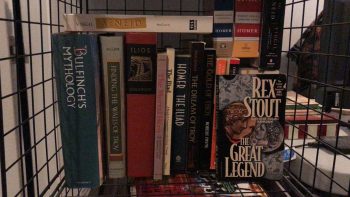 The story of Troy has been my favorite myth since I was a little kid. Greek mythology is far and away my favorite (Norse is a distant second), and I used to check Bullfinch’s out of my grade school library and lug it home. That was a relatively big book. I have my own copy now, of course.
The story of Troy has been my favorite myth since I was a little kid. Greek mythology is far and away my favorite (Norse is a distant second), and I used to check Bullfinch’s out of my grade school library and lug it home. That was a relatively big book. I have my own copy now, of course.
The worst part, is I always root for the Trojans. It never ends well for them. If they had just listened to Laocoon. Though, Athena definitely made that a dangerous proposition…
I’ve used a couple names from Thieves World over the years, in various online RPGs. But hands down, the Iliad has been my main source. Hector, and some variation of Astyanax (I prefer it with more ‘N’ or ‘X’, has far and away my favorite names for fighters (especially paladins). I’ve used a few others, like Penthesilia, Cassandra, and Deiphobus (Helenus just doesn’t work for me).
Way back in pre-Windows days (I think), there was a really cool computer game that included a Troy section. I think you were Jason with his Argonauts, roaming the world. Age of Empires II (man, I played the heck out of that) included a Troy campaign (except I had to sack Troy. Sniff, sniff). There’s a Total War: Troy (kind of a scaled down TW game) that I don’t have yet. You might have read over the past couple weeks that I’m a huge Total War: Warhammer I/II fan.
I don’t do the Assassin’s Creed series, butt there was an Odyssey game, recently. The Odyssey is essentially a sequel to The Iliad. As is Virgil’s The Aeneid.
I read a few translations over the years. But the only version I do now is Robert Fagles’ audiobook. Which, unfortunately, is abridged. I always try to get unabridged versions of books. But for some reason, they never did an unabridged for Fagles. I don’t know what got left out, but it still totally works for me.
I talked about it here, and Derek Jacobi is absolutely FANTASTIC. Probably the best-read audiobook I’ve ever listened to. They had Ian McKellen do Fagles’ Odyssey, and Simon Callow read The Aeneid (Callow is number two, with McKellan still good, but third). Jacobi is nothing short of brilliant.
As I’ve talked about here at Black Gate before, audiobooks let me get to things I otherwise would not read. Old, and new. About once a year, I listen to The Iliad CDs in my car, during the work commute. Some years, I follow it up with The Odyssey. I don’t do The Aeneid that often, but I have listened to it more than once.
The Iliad and The Odyssey are believed to be written not very long apart; both in Greek. As with some of Paul’s Epistles, some think Homer did not author both. I’m just gonna go with ‘Yes, he did.’ The Aeneid as written some six centuries later, in Latin.
 Highly recommend Fagles’ translation, with Jacobi’s reading. I have him doing some Sherlock Holmes and it’s okay. But he slays The Iliad.
Highly recommend Fagles’ translation, with Jacobi’s reading. I have him doing some Sherlock Holmes and it’s okay. But he slays The Iliad.
The Iliad ends with Hector’s funeral games. Homer recounts some of the events after – including that frigging horse – in The Odyssey.
There were other poems by other poets, about The Trojan War. For example, Arctinus of Miletus wrote the five-book Aethiopis. It started right after The Iliad ended, with the arrival of the the Amazon Queen, Penthesileia
There are six additional poems, but sadly, they’re lost. About thirty lines of Lesches of Pyrrha’s Little Iliad is the largest surviving excerpt of these lost Ilios stories. Along with The Iliad and The Odyssey, they make up The Epic (or Trojan) Cycle. Click here for a short look at the lost poems.
I bought Heinrich Schliemann’s Ilios decades ago. It is not exactly light reading. The Mortal Hero is a nice intro to The Iliad, and I recommend that for somebody wanting to dig into it, without actually reading the epic. Though I think should read Homer.
The Brad Pitt movie, Troy, was a big-budget telling of the story. It took out all the mythology. Maybe that made sense from an on-screen perspective, but I was disappointed. It’s an okay movie. I waited a long time for somebody to make Troy, and to make 42 (the Jackie Robinson story). I much prefer the latter.
I tried to sit through the 2018 mini-series, Troy: Fall of A City. What an unwatchable load of garbage.
On my ever-growing ‘To Write About’ list here at Black Gate, is Rex Stout’s The Great Legend. Stout, of course, created Nero Wolfe, who I have written about extensively here at Black Gate. He took the gods out of the picture, and told an alternate story. I like it.
Stephen Fry has written three apparently ‘different’ books on Greek mythology, with book three on Troy. I’m not interested, and haven’t checked them out.
I’m listening to Barry Strauss’ 2007 book, The Trojan War: A New History. The reader’s voice doesn’t do much for me so it’s gonna be a slow almost 9 hours, but it’s interesting enough, an hour in.
An idea I’ve had,which I won’t commit the time and effort to, is a daily FB series. I would post amusing (to me) daily updates from some embedded poet/journalist:
“And we’ve landed on a rather nice beach. I imagine we’ll wrap this up in a week or two and head back home.”
Or maybe a foot soldier in the Greek ranks:
“Man, Achilles was in a foul mood this morning. That guy needs to lighten up.”
So, this has just been some rambling on something I’ve been interested in for most of my life.

Bob Byrne’s ‘A (Black) Gat in the Hand’ made its Black Gate debut in 2018 and has returned every summer since.
His ‘The Public Life of Sherlock Holmes’ column ran every Monday morning at Black Gate from March, 2014 through March, 2017. And he irregularly posts on Rex Stout’s gargantuan detective in ‘Nero Wolfe’s Brownstone.’ He is a member of the Praed Street Irregulars, founded www.SolarPons.com (the only website dedicated to the ‘Sherlock Holmes of Praed Street’).
He organized Black Gate’s award-nominated ‘Discovering Robert E. Howard’ series, as well as the award-winning ‘Hither Came Conan’ series. Which is now part of THE Definitive guide to Conan. He also organized 2023’s ‘Talking Tolkien.’
He has contributed stories to The MX Book of New Sherlock Holmes Stories — Parts III, IV, V, VI, XXI, and XXXIII.
He has written introductions for Steeger Books, and appeared in several magazines, including Black Mask, Sherlock Holmes Mystery Magazine, The Strand Magazine, and Sherlock Magazine.
Half a Century of Reading Tolkien: Part Two – The Fellowship of the Ring by JRR Tolkien
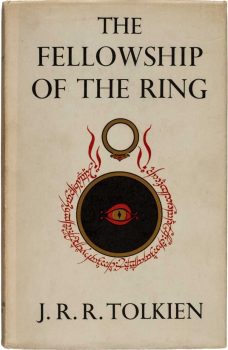 ‘I will take the Ring,’ he said, ‘though I do not know the way.’
‘I will take the Ring,’ he said, ‘though I do not know the way.’
Frodo from The Council of Elrond from The Fellowship of the Ring (1954)
I never saw it, but once upon a time, some hippies and ancillary types were given to emblazoning FRODO LIVES on bedroom walls and the backs of denim jackets. The Lord of the Rings, the literary creation of a conservative Oxford University professor of English Literature and Language, had somehow hit a chord with the nascent counterculture after its publication in 1954/1955. I imagine, in fact, I know, there are all sorts of popular and academic works purporting to explain why this was. I’ve never been interested in them, preferring the books themselves to present the professor’s ideas.
I have my own, if not particularly original, theories. First, it’s a great adventure story featuring a small, ineffectual-seeming hero who stands up to his world’s greatest force of evil. Second, it came to be seen as a sort of rallying cry against the dark powers of the modern world. I don’t know Prof. Tolkien’s politics, though I suspect he was a small-c conservative. It’s clear he viewed the loss of tradition and the dark Satanic mills blotting out the green and pleasant England of his youth were a terrible assault on civilization (this anti-modernist attitude is an important element of Michael Moorcock’s disdain for him). Third, the counterculture’s love for anything pastoral and ante-technological was probably the most important reason for its breakout into the mainstream’s consciousness.
I never discussed it with him, but I feel confident when writing that my father liked The Lord of the Rings primarily for the first reason and somewhat for the second (he was very much a BIG-C conservative) a bit. He most definitely did not like it for the last. When I first read it all that mattered to me was that first reason. With every revisit over the ensuing decades, I’ve discovered something new. That has carried on with my most recent reread.
For the handful of uninitiated out there, The Fellowship of the Ring (comprised of two books, Book I: The Ring Sets Out and Book II: The Ring Goes South), tells of the discovery that the magic ring Bilbo Baggins found in The Hobbit is really the single most evil artifact in the world and the start of the quest to destroy it. Bilbo’s heir, Frodo, and his gardener, Sam Gamgee, at the advice of the wizard Gandalf, set out for Rivendell. Following up on his suspicions about the ring, Gandalf spent over a decade hunting down the true nature of the ring. Finally, he determined Bilbo’s ring was the One Ring, the thing by which the Dark Lord (probably the first of such figures in fantasy fiction), Sauron, could seize control of all Middle-earth.
The four hobbits encounter numerous obstacles along the road to Rivendell of increasing peril. The most dangerous is their pursuit by the Nazgûl (Ring Wraiths). They are Sauron’s greatest servants, corrupted ages ago by lesser rings he made for Men.
In Rivendell, a plan is devised to destroy the Ring by dropping it in Mount Doom, the volcano it was originally forged in and the only thing that can destroy it. A party of nine, chosen from representatives of the different races of Middle-earth and led by Gandalf, set out toward the Dark Lord’s land, Mordor. Of course, things start going wrong right away. Before The Fellowship‘s end, two of the nine companions are dead, and the rest are split into three separate groups. I’ll leave it there. If you’ve read the books, you can fill in the blanks and if you haven’t, well, go fix that giant gap in what you’ve read.
 Moria by Alan Lee
Moria by Alan Lee
The book remains as enthralling to me as did when I first read it nearly fifty years ago. It’s filled with numerous scenes that filled me with awe on the first encounter that has never left me over the years. There are the monolithic Argonath, statues of ancient kings, standing watch over the borders of the kingdom of Gondor and the tree city of Caras Galadhon. The most striking thing was the ancient dwarven city of Khazad-dûm. I knew dwarves lived underground, but I hadn’t imagined anything like Moria. Like the nine companions, the readers are only given glimpses of Moria’s dark passageways, but they’re enough to convey its massiveness and harsh beauty.
Gandalf seemed pleased. ‘I chose the right way,’ he said. ‘At last we are coming to the habitable parts, and I guess that we are not far now from the eastern side. But we are high up, a good deal higher than the Dimrill Gate, unless I am mistaken. From the feeling of the air we must be in a wide hall. I will now risk a little real light.’
He raised his staff, and for a brief instant there was a blaze like a flash of lightning. Great shadows sprang up and fled, and for a second they saw a vast roof far above their heads upheld by many mighty pillars hewn of stone. Before them and on either side stretched a huge empty hall; its black walls, polished and smooth as glass, flashed and glittered. Three other entrances they saw, dark black arches: one straight before them eastwards, and one on either side. Then the light went out.
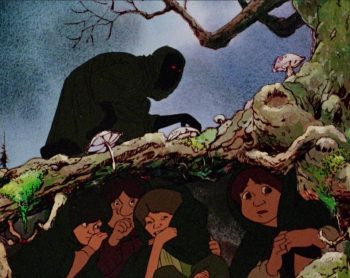 Ralphi Bakshi’s rotoscoped Ring Wraith and the hobbits
Ralphi Bakshi’s rotoscoped Ring Wraith and the hobbits
This time around, the outward journey of the hobbits, Frodo, Sam, Merry, and Pippin, from the bucolic seclusion of the Shire, by degrees, into the wider, wilder world they have been largely unaware of caught my eye. The first encounter occurs while still in the Shire when they hear the sound of hooves coming along the road.
The hoofs drew nearer. They had no time to find any hiding-place better than the general darkness under the trees; Sam and Pippin crouched behind a large tree-bole, while Frodo crept back a few yards towards the lane. It showed grey and pale, a line of fading light through the wood. Above it the stars were thick in the dim sky, but there was no moon.
The sound of hoofs stopped. As Frodo watched he saw something dark pass across the lighter space between two trees, and then halt. It looked like the black shade of a horse led by a smaller black shadow. The black shadow stood close to the point where they had left the path, and it swayed from side to side. Frodo thought he heard the sound of snuffling. The shadow bent to the ground, and then began to crawl towards him.
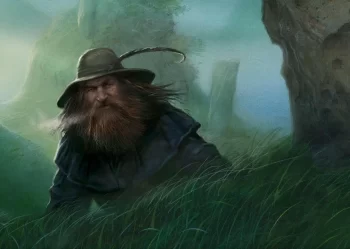 Tom Bombadil by John Howe
Tom Bombadil by John Howe
The second and stranger encounter occurs in the shadowed depths of the Old Forest. Once, many years ago, something from the Forest had somehow pushed back against the invading hobbits. In retaliation, the hobbits burned many of the trees and built a great hedge to keep the rest of them at bay. Once inside the dark woods, the hobbits are lured and trapped by an ancient, malicious willow tree only to be saved by one of the most divisive figures in fantasy – Tom Bombabil. Tom saves the hobbits again, as they continue away from their homes, and are trapped by evil spirits infesting ancient barrows. Their experience in the barrows gives visions to the hobbits, impressing on them the depths and width of the world outside their cozy borders.
This brings me to the second thing I paid more attention to on this reading: the moments of mystery and strangeness. Some hate Bombadil because he’s too frivolous. Others maintain he was just jammed into the story because Tolkien, who’d created the character for an earlier poem, liked him too much. I hold to the theory that for the whole first part of The Fellowship, Tolkien was feeling his way into the story, letting events grow spontaneously and I love the character, silly songs and all.
In the seemingly areligious Middle-earth (that’s a complicated bit of business for some other time, perhaps), Bombabil feels distinctly divine. He is married to the daughter of the river, “knew the dark under the stars when it was fearless – before the Dark Lord came from Outside,” and sings down the very stones of the haunted barrow. When asked about him, Tolkien responded that he was “not an important person – to the narrative” and that “he represents something that I feel important, though I would not be prepared to analyse the feeling precisely. I would not, however, have left him in, if he did not have some kind of function.” He alone, of everyone in Middle-earth, is impervious to the power of the Ring. It doesn’t work for him and he has no desire to own it. I love that there is no explanation for him, an element that doesn’t find an explanation in any of the vast history Tolkien composed for Middle-earth. To quote his wife, when asked who he is, she simply replies, “He is.”
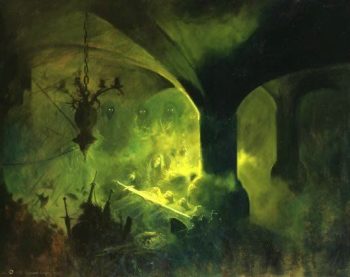 Barrow Wight by Paul Raymond Gregory
Barrow Wight by Paul Raymond Gregory
Being swallowed alive by a willow tree, evil or otherwise, is of course fairy tale strange. The haunted barrows and the capture of the hobbits by the barrow wights are more akin to the Germanic tales that partially inspired Tolkien. Trying to cross the downs, the hobbits find themselves imprisoned within one of the barrows. It is the eeriest point in the entire book, and could easily have been lifted from some skald’s ancient tale sung by the fireside.
As he lay there, thinking and getting a hold of himself, he noticed all at once that the darkness was slowly giving way: a pale greenish light was growing round him. It did not at first show him what kind of a place he was in, for the light seemed to be coming out of himself, and from the floor beside him, and had not yet reached the roof or wall. He turned, and there in the cold glow he saw lying beside him Sam, Pippin, and Merry. They were on their backs, and their faces looked deathly pale; and they were clad in white. About them lay many treasures, of gold maybe, though in that light they looked cold and unlovely. On their heads were circlets, gold chains were about their waists, and on their fingers were many rings. Swords lay by their sides, and shields were at their feet. But across their three necks lay one long naked sword.
Suddenly a song began: a cold murmur, rising and falling. The voice seemed far away and immeasurably dreary, sometimes high in the air and thin, sometimes like a low moan from the ground. Out of the formless stream of sad but horrible sounds, strings of words would now and again shape themselves: grim, hard, cold words, heartless and miserable. The night was railing against the morning of which it was bereaved, and the cold was cursing the warmth for which it hungered. Frodo was chilled to the marrow. After a while the song became clearer, and with dread in his heart he perceived that it had changed into an incantation:
Cold be hand and heart and bone,
and cold be sleep under stone:
never more to wake on stony bed,
never, till the Sun fails and the Moon is dead.
In the black wind the stars shall die,
and still on gold here let them lie,
till the dark lord lifts his hand
over dead sea and withered land.
He heard behind his head a creaking and scraping sound. Raising himself on one arm he looked, and saw now in the pale light that they were in a kind of passage which behind them turned a corner. Round the corner a long arm was groping, walking on its fingers towards Sam, who was lying nearest, and towards the hilt of the sword that lay upon him.
None of these moments make it into Peter Jackson’s film of The Fellowship of the Ring. They don’t serve the narrative thrust Jackson chose to focus on. What they do is help convey the transition of the hobbits — and the story — from the pocket world of the Shire to the real world, one beset by betrayal, ravaging armies, and supernatural evil. Taken together with the dangerous episodes, they serve as a sort of veil the hobbits, representatives of the traditional, insular England Tolkien loved, must pass through before the real quest — the one to destroy the Ring — can begin.
Which leads me to Jackson’s movie, The Fellowship of the Ring (2001). That’s in fact what started this whole undertaking. Even though I’m on record disliking the movies, I needed something on in the background while doing some work and something with swords and magic seemed the right choice. Within minutes I found my dislike bubbling up. Soon it was boiling over. The easiest solution was to just pick up the books and read them again — which I did.
The thing is, I kept watching the movie, quickly followed by the other two. It’s the closest I’ve come to really hate watching anything in my life. I’ll go into more detail when I get to The Two Towers and The Return of the King as they deviate the most from the books.
I don’t dislike the movies for things Jackson didn’t do. If Verdi can edit Shakespeare, Jackson can edit Tolkien. I understand leaving out all the things I described. While I think their elimination changes the nature of the story, removing them to speed up the film’s momentum makes cinematic sense. The movie is intended as an exciting, action-filled movie, not a travelogue. Characters are compressed or excised in service of fitting a large book onto the screen. It happens all the time, often quite successfully. And still, I dislike the movies.
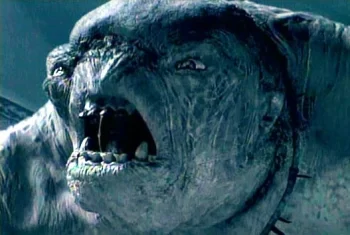 My easiest complaint is with filmmaking choices. First, are the moments of slow motion. Frodo getting stabbed and an uruk-hai running along a riverbank are the two moments that jump to mind most readily. They look cheap and terrible and stand out in a movie that lavished millions on looking good. Much worse is the fight and flight through Moria which becomes increasingly computer game-like as it proceeds. There is no architectural explanation that can possibly justify the staircase that collapses as our heroes are running down it. The battle in the book is much better choreographed and makes much more sense. Jackson’s camera work is skittery and nothing ever stays in a shot long enough to make much of an impression. The interaction between the characters and CGI troll looked fake twenty-plus years ago and only more so now. There are numerous other moments of interpretation I could argue about. Jackson always chose BIGGER and BOLDER, eschewing texture, subtlety, and atmosphere.
My easiest complaint is with filmmaking choices. First, are the moments of slow motion. Frodo getting stabbed and an uruk-hai running along a riverbank are the two moments that jump to mind most readily. They look cheap and terrible and stand out in a movie that lavished millions on looking good. Much worse is the fight and flight through Moria which becomes increasingly computer game-like as it proceeds. There is no architectural explanation that can possibly justify the staircase that collapses as our heroes are running down it. The battle in the book is much better choreographed and makes much more sense. Jackson’s camera work is skittery and nothing ever stays in a shot long enough to make much of an impression. The interaction between the characters and CGI troll looked fake twenty-plus years ago and only more so now. There are numerous other moments of interpretation I could argue about. Jackson always chose BIGGER and BOLDER, eschewing texture, subtlety, and atmosphere.
Tolkien’s Lord of the Rings isn’t devoid of humor. There’s Bilbo’s speech at his party and the discovery of the petrified trolls from The Hobbit. The thing is, there isn’t any slapstick. Not a bit. By which I mean especially pan-swinging, or dwarf-tossing. It’s awful and, like the slow motion, stands out in a movie that presents itself as a serious interpretation of a serious literary work.
My greater criticism is the film’s handling of the characters. Merry and Pippin are reduced to bad comic relief, instead of the clever conspirators who prove brave enough to maim and kill several orcs before Boromir is killed. Gandalf acts like a terrified fool in one moment and isn’t clever enough to solve the riddle to open the Gates of Moria himself. Boromir is more despicable seeming on the screen, instead of a man slowly being driven to madness by the Ring.
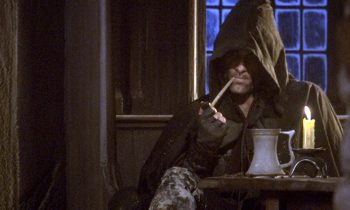 Most egregiously, Aragorn, born of an ancient line of kings, and raised to be a king, becomes a reluctant hero on the screen. We’re told he turned from the path of kingship long ago and later he says being king isn’t his goal. Aragorn is a man who has been a hero several times during his long life prior to the book, all for the purpose of opposing Sauron and restoring the kingship of a reunited kingdom. Finally, Elrond’s sworn he may only marry his daughter, Arwen, if he succeeds in his quest to become king.
Most egregiously, Aragorn, born of an ancient line of kings, and raised to be a king, becomes a reluctant hero on the screen. We’re told he turned from the path of kingship long ago and later he says being king isn’t his goal. Aragorn is a man who has been a hero several times during his long life prior to the book, all for the purpose of opposing Sauron and restoring the kingship of a reunited kingdom. Finally, Elrond’s sworn he may only marry his daughter, Arwen, if he succeeds in his quest to become king.
Instead of channeling the great heroes and chieftains of legend, Aragorn is reduced to, using one online site’s description, emo Aragorn. It feels like Jackson was incapable of believing someone could simply be portrayed as a hero, but needed to go on some sort of journey that almost forced him into choosing to be king.
There are loads of other things I don’t like about the movie. Most, though, are matters of taste, I suppose. Neither Viggo Mortensen nor Sean Bean are physically big enough or powerful enough for their roles. I don’t like many of the costumes, and I hate the portrayal of the hobbits as country bumpkins and Frodo is too young. The worst thing in the extended edition is the elf guard at Lothlorien’s five o’clock shadow.
I do like some things. Ian McKellen looks perfect. The Shire and the much of the wilderness countryside look like how I imagine they should. Galadriel taking on a terrifying visage when she imagines what she’d be with the One Ring is as exactly disturbing as it should be. Best of all, the death of Boromir, something that doesn’t come across as grandly tragic in the book as it should, is done brilliantly on the screen. That’s about it, though.
If this all seems a bit rambling, I’m sorry. Like last month, the spirit of Tolkien overpowered any original intentions I had. The result is this wandering around how The Fellowship of the Ring struck me on this tenth, or whatever it is, reading. I think I concentrated on those early chapters because excised from the movies, they are unknown to many who’ve never actually read the books. The book is much looser and messier than the movies and maybe that’s a reason I prefer it.
Fletcher Vredenburgh writes a column each first Sunday of the month at Black Gate, mostly about older books he hasn’t read before. He also posts at his own site, Stuff I Like when his muse hits him.
Roy Thomas and the Legacy of Conan the Barbarian
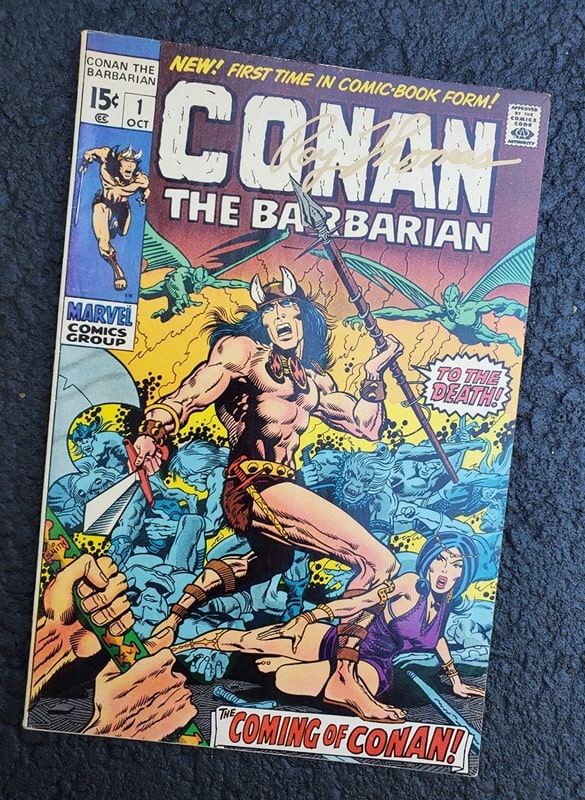 Conan The Barbarian #1 (Marvel Comics, October 1970). Art by Barry Windsor Smith
Conan The Barbarian #1 (Marvel Comics, October 1970). Art by Barry Windsor Smith
The package I received on July 6, 2020 brought me great joy! Roy Thomas is my favorite comic book writer. I correspond with him occasionally, and he is quite generous with his time, sharing his thoughts and memories. Very similar to how Gary Gygax did this, treating every fan with dignity and respect. A true gentleman.
I thanked Roy in my latest Hyperborea adventure book, The Sea-Wolf’s Daughter, because it included a character inspired by one of his creations. I sent him a copy of the book, and along with it my personal copy of Conan the Barbarian #1, to be signed by the author. Well, here it is! (He has an agency that normally handles this sort of thing, but he made an exception for me.) Excelsior!
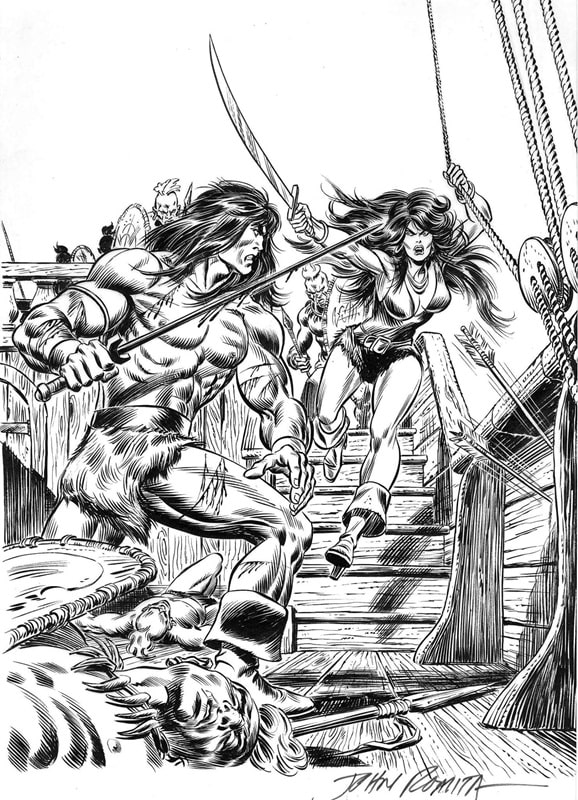 Cover art for Conan the Barbarian #58, by John Romita Sr., story by Roy Thomas (Marvel Comics, January 1976)
Cover art for Conan the Barbarian #58, by John Romita Sr., story by Roy Thomas (Marvel Comics, January 1976)
It is my humble opinion that of all the Conan pastiche writers, Roy Thomas is among the finest. But because he wrote in the comics industry, he’s often not afforded the same prestige as other Conan pastiche writers, such as L. Sprague de Camp, Lin Carter, Karl Edward Wagner, Robert Jordan, et al.
Thomas’ run starring Conan and Belit (the Queen of the Black Coast) started with this issue (#58) and concluded with the iconic issue #100. It is a treasure to read.
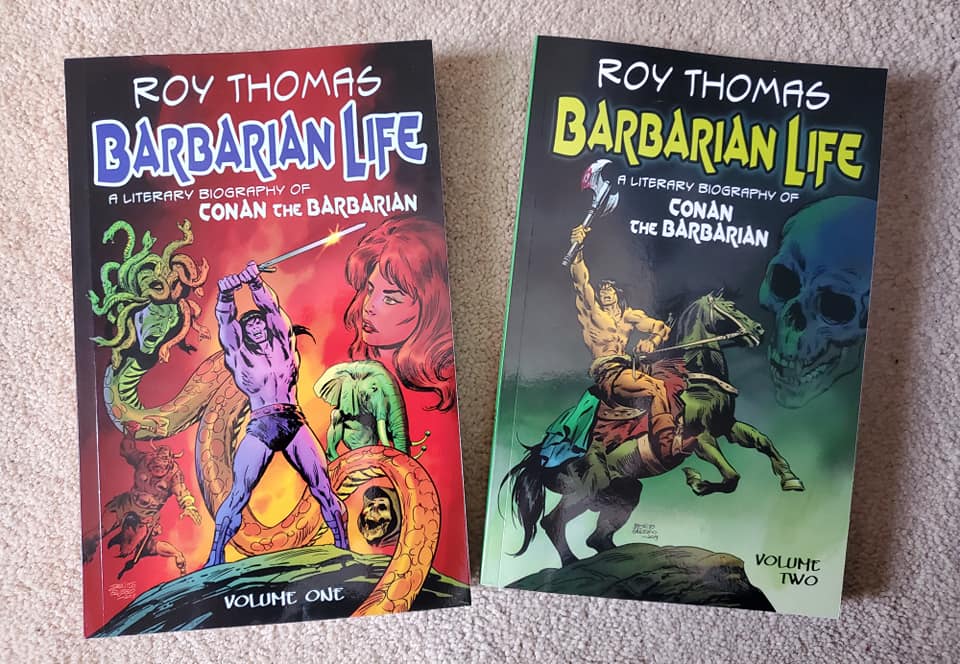 The first two volumes of Barbarian Life by Roy Thomas (Pulp Hero Press, December 7, 2018 and November 29, 2019)
The first two volumes of Barbarian Life by Roy Thomas (Pulp Hero Press, December 7, 2018 and November 29, 2019)
In the three volumes of Barbarian Life, Roy Thomas reflects on each of the first 100 issues of Conan the Barbarian, by Marvel Comics — which he wrote every issue of, from 1970 to 1979.
Roy is responsible for taking part in the creation of many Marvel and DC characters that have been featured in blockbuster films, but he will be the first to tell you that his favorite job was writing Conan the Barbarian, adapting and expanding on the works of Robert E. Howard and several other pastiche writers. What an incredible idea by Mr. Bob Mclain of Pulp Hero Press!
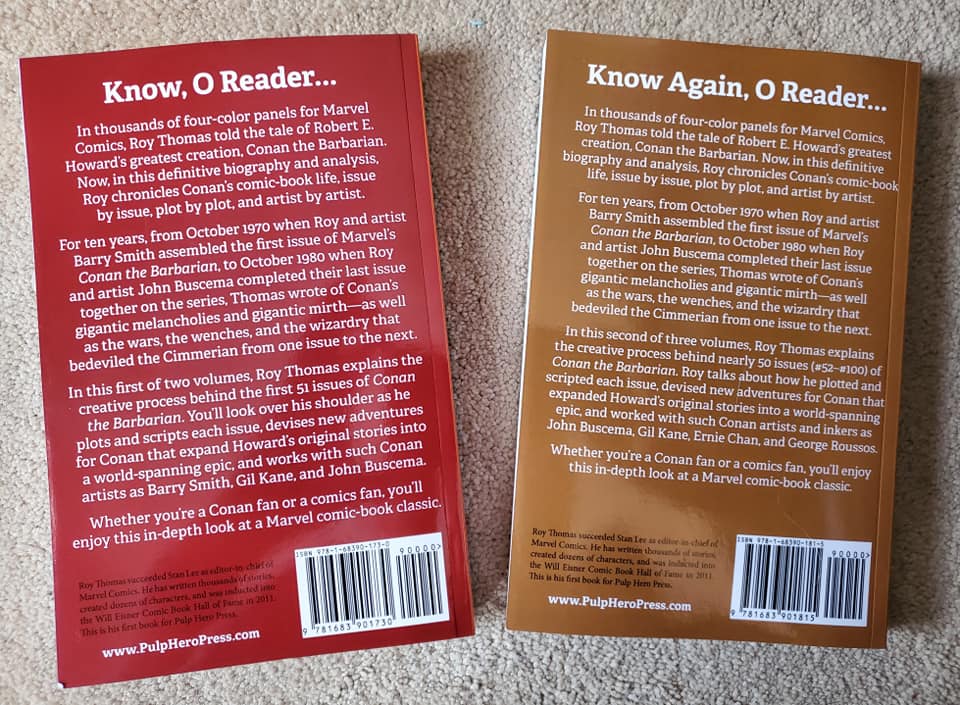 Back covers for Barbarian Life, volumes 1 and 2
Back covers for Barbarian Life, volumes 1 and 2
I can’t wait to dig into these two volumes; in fact, I have this crazy notion in me noggin about starting a blog in which I go through all 100 issues, reading the comic, followed by its respective chapter entry in the literary biography.
I’ve never blogged before, but I think this could be my motivation to give it a try in 2020. Would anyone be interested reading something like this?
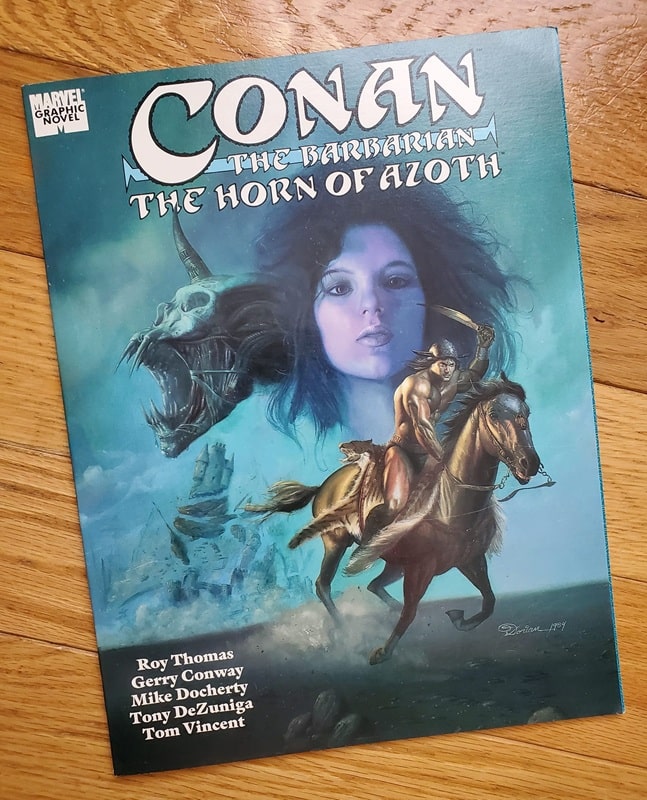 Conan: The Horn of Azoth, by Roy Thomas, Gerry Conway, Mike Docherty, Tony DeZungia, and Tom Vincent (Marvel Enterprises, January 1, 1990)
Conan: The Horn of Azoth, by Roy Thomas, Gerry Conway, Mike Docherty, Tony DeZungia, and Tom Vincent (Marvel Enterprises, January 1, 1990)
Above is Conan: The Horn of Azoth, aka Conan, King of Thieves, aka Conan the Destroyer.
Written by Roy Thomas and Gerry Conway, penciled by Mike Docherty, inked by Tony DeZuniga, and colored by Tom Vincent, this graphic novel, published in 1990 by Marvel Comics, has a fascinating publication history. For the complete history, definitely read the introduction by Thomas and Conway. What I am presenting is an abridged version of that story.
– It didn’t start off as a graphic novel; rather, it was the screenplay for the second Conan film, starring Arnold Schwarzenegger.
– In 1982, Universal producer Ed Pressman hired Thomas and Conway to write the script. Roy Thomas had previously worked as a consultant for the Conan the Barbarian.
– Roger Donaldson was to be the director.
– Barry Windsor-Smith was brought in to do concept art.
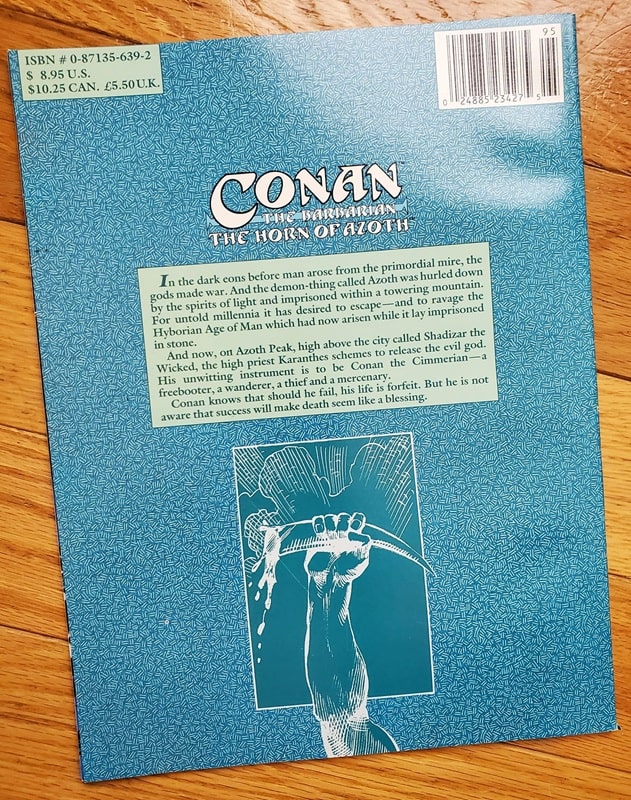 Back cover for Conan: The Horn of Azoth
Back cover for Conan: The Horn of Azoth
– Universal producer Pressman wanted it to be “lighter” (PG), so Thomas and Conway had to jettison some of their ideas. Result was their screenplay, Conan, King of Thieves.
– Pressman loved the screenplay, but sold his rights to Dino DeLaurentis.
– Dino was less familiar with REH and Conan, and he had his own ideas.
– The director, Donaldson, was removed. Dino wanted a lot of changes to the script. The storyline was continually adjusted.
– Dino hated leeches and rats and had them removed from the script. He wanted no stop-animation monster transformation, so the main monster had to be changed.
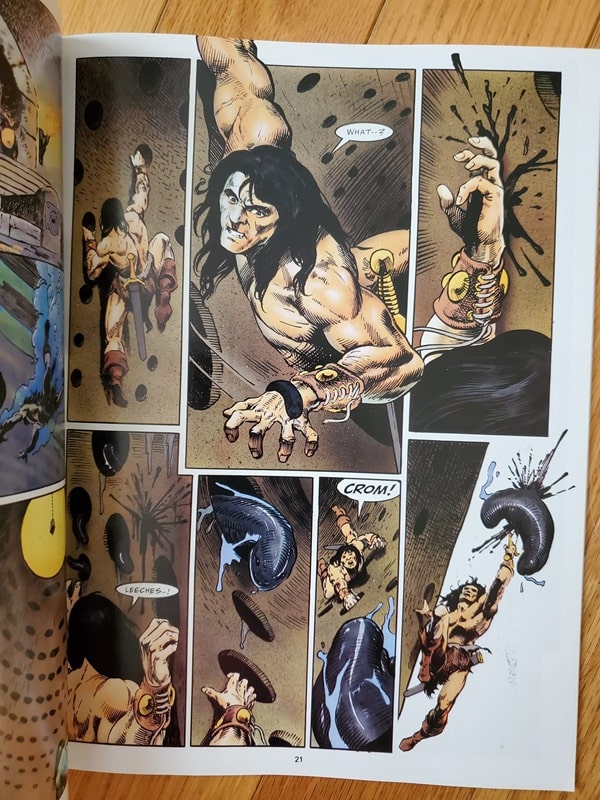
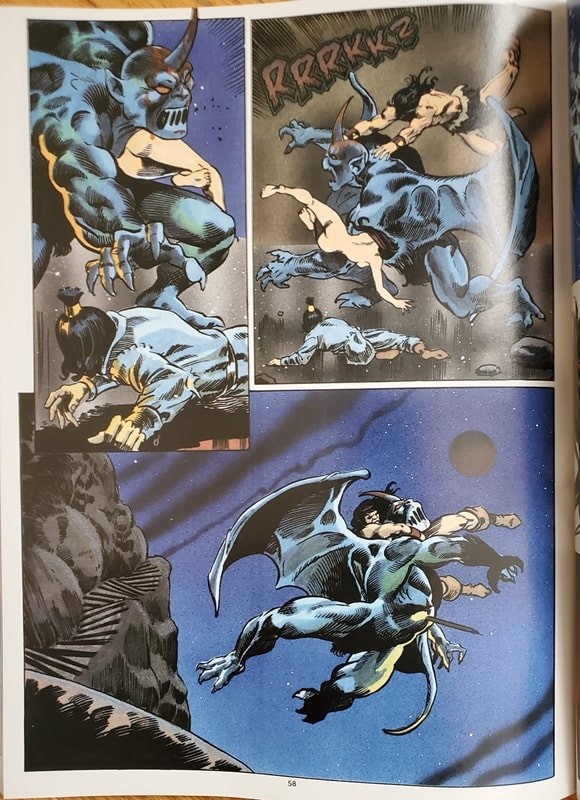
Interiors from The Horn of Azoth
– Richard Fleischer was hired as director. He came in with his own ideas and hired a new screenwriter to replace Thomas and Conway.
– Thomas and Conway had to fight for a screen credit in Conan the Destroyer. The Writers Guild decided that there were significant elements of the Thomas and Conway script that were retained, so they won.
– The original screenplay by Thomas and Conway was well-liked in the industry and led to further work for the two.
– Marvel editor Craig Anderson loved it, too, so they turned it from a 130-page screenplay to a 62-page graphic novel, published by Marvel.
And there you have it, Conan: The Horn of Azoth.
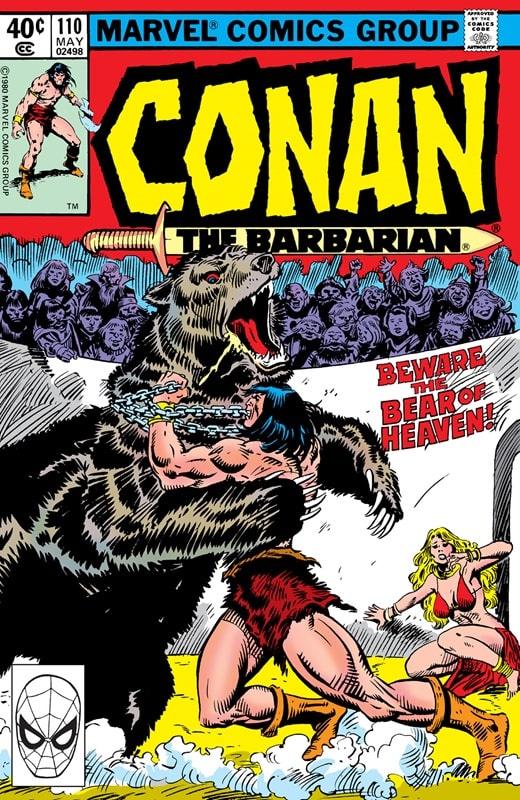 Conan the Barbarian #110, by Roy Thomas, John Buscema, and Al Milgrom (Marvel Comics, May 1980)
Conan the Barbarian #110, by Roy Thomas, John Buscema, and Al Milgrom (Marvel Comics, May 1980)
This is the first Conan the Barbarian comic that I ever read. Released in February of 1980 (with a cover date of May 1980), I would have been eight years old, soon to be nine.
I remember reading it over and over at my grandmother’s house, then redrawing it, too, making my own versions of Conan choking out a massive bear using a chain.
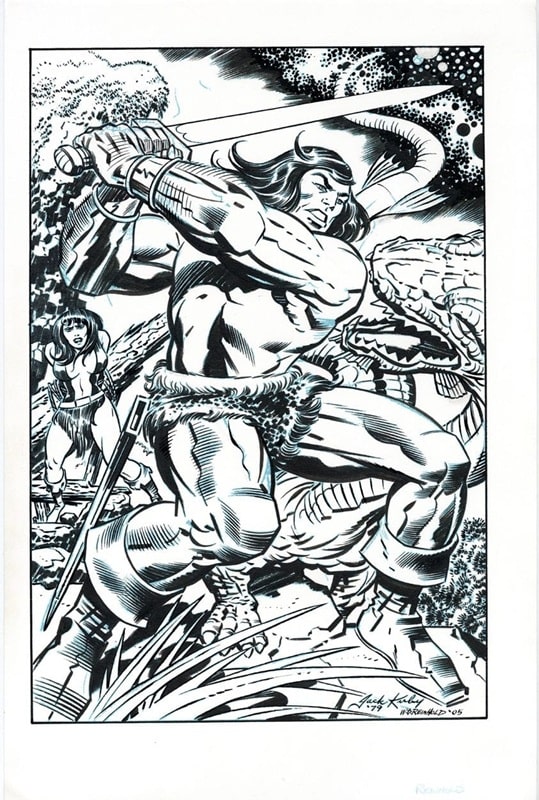 Conan by Jack Kirby
Conan by Jack Kirby
And here’s Conan the Barbarian, by Jack Kirby. Jack was not known for many Conan illustrations, but by Crom, this one is incredible.
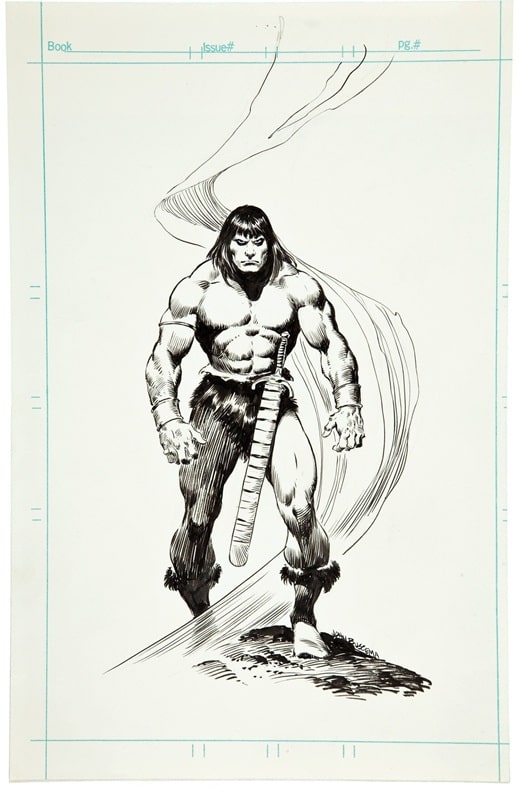 Conan by John Buscema
Conan by John Buscema
January 10, 2025 marked 23 years since the passing of the great John Buscema. His resume of artistic works is astonishing, to say the least, but for many of us (myself included), we will always remember him most for his Conan works (Conan the Barbarian, Savage Sword of Conan). When I read a Conan story (by REH or a pastiche author), and I picture Conan in my mind’s eye, I am seeing Big John’s rendition of the Cimmerian barbarian. Hail to John!
Jeffrey P. Talanian’s last article for Black Gate was The Intersection of Hobbies: Dungeons & Dragons, John Eric Holmes, and Tarzan. He is the creator and publisher of the Hyperborea sword-and-sorcery and weird science-fantasy RPG from North Wind Adventures. He was the co-author, with E. Gary Gygax, of the Castle Zagyg releases, including several Yggsburgh city supplements, Castle Zagyg: The East Mark Gazetteer, and Castle Zagyg: The Upper Works. Read Gabe Gybing’s interview with Jeffrey here, and follow his latest projects on Facebook and at www.hyperborea.tv.
Explore the Top 3 Rooftop Tents for Spring Camping 2025
As the weather warms up and nature beckons, spring camping becomes an enticing option for outdoor enthusiasts like you. Rooftop tents offer a unique way to experience the great outdoors, providing comfort and convenience while keeping you elevated and away from the ground. In this article, we will explore the top three rooftop tents for spring camping in 2025, helping you make an informed decision that enhances your outdoor adventures.
Top Picks- Best Overall: Naturnest Rooftop Tent – Andromeda Yellow – $999.00
- Best Value: Naturnest Rooftop Tent Hard Shell – Polaris 2 – $1,599.00
- Best for Families: Rooftop Tent Hard Shell – PEAKUNWIND – $1,999.00
When selecting the best rooftop tent for your spring camping needs, consider factors such as ease of setup, durability, weather resistance, and overall comfort. Each of these tents has been chosen based on their performance in these areas, ensuring you have a reliable shelter for your outdoor adventures.
Naturnest Rooftop TentThe Naturnest Rooftop Tent is your perfect companion for spring camping adventures. Designed for two, this tent offers a great view and excellent ventilation, making it ideal for stargazing or enjoying a gentle breeze while you relax. It’s lightweight at just 121 pounds, which means you can easily mount it on your vehicle without worrying about extra fuel consumption. Plus, it’s waterproof, windproof, and UV-resistant, ensuring you stay comfortable in various weather conditions. Whether you’re planning a weekend getaway or a longer road trip, this tent is a fantastic choice for both casual and serious campers.
What People SayUsers rave about the Naturnest Rooftop Tent’s ventilation and quality. Many appreciate how easy it is to set up and the comfort it provides, making it a favorite for outdoor enthusiasts.
-
My god, the ventilation and view of this tent are amazing. As you can see, it has doors and windows on all sides, and the top of the tent can also be opened. I drove to the suburbs and really tried to lie in the tent to see the stars. Guys, go outside and feel the nature. You will be grateful for it.
– GEORGE FREEMAN
-
I am impressed by the quality of this tent. The outer fabric is made of 420D Oxford cloth, which feels very thick and smooth, with no seam problems at all. It is completely waterproof, sun-proof, and completely blackout, providing a fully enclosed and safe interior space for outdoor camping.
– Julius Tayag
Pros:
- Excellent ventilation with multiple windows
- Lightweight design for easy transport
- High-quality materials ensure durability
Cons:
- Requires a vehicle with a roof rack for installation
- Great ventilation and view
- Lightweight and easy to install
- Durable and waterproof materials
Perfect for weekend camping trips, road trips, or even spontaneous outdoor adventures. The tent’s design allows you to enjoy nature without compromising comfort.
Current Price: $999.00
Rating: 5 (Total: 3+)
Naturnest Rooftop TentThe Naturnest Rooftop Tent is designed to elevate your spring camping experience. With a spacious layout for two, this tent not only provides a cozy spot to sleep but also offers stunning views and excellent ventilation. Weighing in at 185 pounds, it’s manageable for mounting on your vehicle, making it a practical choice for both weekend getaways and extended road trips. Plus, it’s built to withstand the elements—waterproof, windproof, and UV-resistant—so you can enjoy your adventures without worrying about the weather. Whether you’re stargazing or simply enjoying the fresh air, this tent is a fantastic addition to your outdoor gear.
What People SayUsers appreciate the Naturnest Rooftop Tent for its comfort and thoughtful design. Many highlight the ample storage options and the cozy mattress, making it a great choice for both casual campers and serious adventurers.
-
It is perfect for outdoor campers. It is very safe, the mattress is comfortable, the space is not too small, I think it can accommodate 2 people, it also has no condensation, and there are LED lights and multiple storage bags inside. Worth buying.
– lee jung ho
Pros:
- Comfortable mattress and spacious interior
- LED lights and storage bags enhance usability
- Durable construction for various weather conditions
Cons:
- Requires a vehicle with a roof rack for installation
- Spacious and comfortable for two
- Weather-resistant for all seasons
- Easy setup with thoughtful design features
This tent is perfect for weekend camping trips, spontaneous outdoor adventures, or even as a cozy retreat in your backyard. Its design allows you to enjoy nature comfortably, no matter where you are.
Current Price: $1,599.00
Rating: 5 (Total: 1+)
PEAKUNWIND Rooftop TentThe PEAKUNWIND Rooftop Tent is your go-to companion for spring camping adventures. With enough space for four people, this hard-shell tent is designed for comfort and convenience. Its Z-shaped design not only maximizes interior space but also ensures you can sit up comfortably without bumping your head. Setting it up is a breeze—just unlock the buckle, push up the ends, and let the air pressure rods do the work. Plus, it’s waterproof, UV-resistant, and built to withstand various weather conditions, making it perfect for both weekend getaways and longer trips. Whether you’re camping in the mountains or enjoying a night under the stars in your backyard, this tent is a fantastic choice.
What People SayUsers rave about the PEAKUNWIND Rooftop Tent for its spacious interior and hassle-free setup. Many appreciate the thoughtful accessories included, like the telescoping ladder and storage bags, which enhance the overall camping experience.
-
The Z-shaped design gives this rooftop tent plenty of space. I can sit and stretch without hitting my head, which is a huge plus. The extra room makes it perfect for longer trips.
– LEONARD W JOHNSON
Pros:
- Ample space for a comfortable camping experience
- Quick setup process saves time
- Includes useful accessories for convenience
Cons:
- Requires a vehicle with a roof rack for installation
- Spacious enough for four people
- Quick and easy setup
- Durable and weather-resistant materials
This tent is ideal for family camping trips, spontaneous adventures with friends, or even as a cozy escape in your own backyard. Its design allows you to enjoy the great outdoors comfortably, no matter where your travels take you.
Current Price: $1,999.00
Rating: 5 (Total: 3+)
FAQ What should I consider when choosing a rooftop tent for spring camping?When selecting a rooftop tent for spring camping, you should consider factors such as size, weight, and weather resistance. Ensure the tent can comfortably accommodate the number of people you plan to camp with. Look for lightweight options if you have a smaller vehicle, and prioritize tents with waterproof and windproof features to handle unpredictable spring weather. Additionally, check the setup time; a tent that can be easily assembled in under 10 minutes will save you time and hassle.
How do I maintain and care for my rooftop tent?To maintain your rooftop tent, regularly clean it with a mild soap and water solution to remove dirt and debris. Avoid harsh chemicals that could damage the fabric. After each use, ensure the tent is completely dry before packing it away to prevent mold and mildew. Store it in a cool, dry place when not in use. Additionally, inspect the seams and zippers periodically to ensure they are functioning properly and reseal them if necessary to maintain waterproofing.
Can I use a rooftop tent on any vehicle, and how do I ensure it fits my car?Not all rooftop tents are compatible with every vehicle, so it’s crucial to check the manufacturer’s specifications for compatibility. Most rooftop tents require a roof rack or crossbars that can support the tent’s weight. Ensure your vehicle’s roof can handle the combined weight of the tent and occupants. You can also consult with your vehicle’s manual or a professional to confirm the load capacity. If you’re unsure, consider visiting a local outdoor retailer for expert advice on fitting a rooftop tent to your specific vehicle.
Wrapping UpChoosing the right rooftop tent can significantly enhance your camping experience. The options highlighted in this article cater to various needs and preferences, ensuring that you can find the perfect fit for your adventures. Whether you prioritize comfort, value, or family-friendly features, these tents are designed to provide you with a memorable outdoor experience this spring.
Naturnest Rooftop Tent – Andromeda Yellow Naturnest Rooftop Tent – Polaris 2 Rooftop Tent Hard Shell – PEAKUNWIND

 Rating
5/5 (3 ratings)
5/5 (1 rating)
5/5 (3 ratings)
Highlights
Lightweight, waterproof, windproof, UV-resistant, 4-season tent for 2 persons.
Hard shell, easy setup, waterproof, windproof, UV-resistant, 4-season tent for 2 persons.
Hardshell, easy setup, blackout privacy, waterproof, UV-resistant, 4-season tent for 4 persons.
Pros
Excellent ventilation, great view, easy setup.
Comfortable mattress, spacious, no condensation.
Spacious interior, quick setup, sturdy design.
Cons
Higher price point.
Heavier than soft-shell options.
Most expensive option.
Price
$999.00
$1,599.00
$1,999.00
Buy Now
Buy Now
Buy Now
Rating
5/5 (3 ratings)
5/5 (1 rating)
5/5 (3 ratings)
Highlights
Lightweight, waterproof, windproof, UV-resistant, 4-season tent for 2 persons.
Hard shell, easy setup, waterproof, windproof, UV-resistant, 4-season tent for 2 persons.
Hardshell, easy setup, blackout privacy, waterproof, UV-resistant, 4-season tent for 4 persons.
Pros
Excellent ventilation, great view, easy setup.
Comfortable mattress, spacious, no condensation.
Spacious interior, quick setup, sturdy design.
Cons
Higher price point.
Heavier than soft-shell options.
Most expensive option.
Price
$999.00
$1,599.00
$1,999.00
Buy Now
Buy Now
Buy Now
The post Explore the Top 3 Rooftop Tents for Spring Camping 2025 first appeared on Rooftop Tents.
“The Lesson of the Master” and “The Master” | 2 Books in Conversation
Colm Tóibín, in his introduction to the 2007 edition of Henry James’ classic novella The…
The post “The Lesson of the Master” and “The Master” | 2 Books in Conversation appeared first on LitStack.
UNHALLOWED HALLS by Lili Wilkinson
Midnight Rambles: H.P. Lovecraft in Gotham by David J. Goodwin
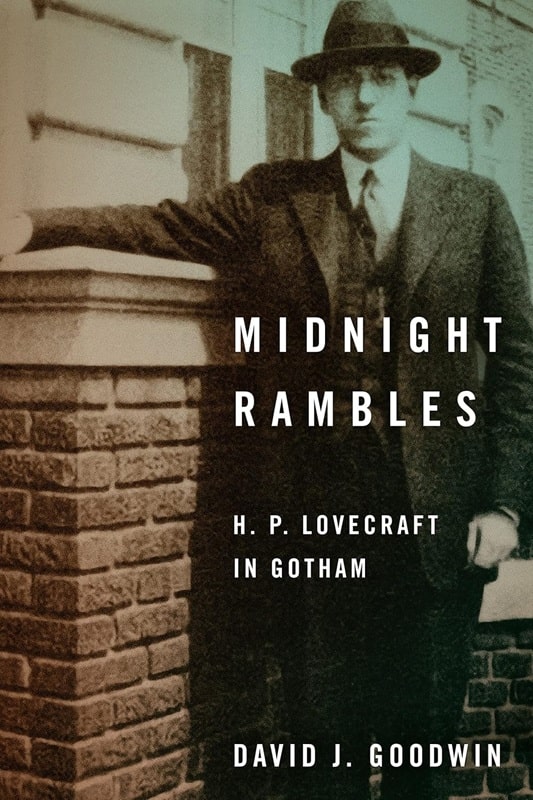
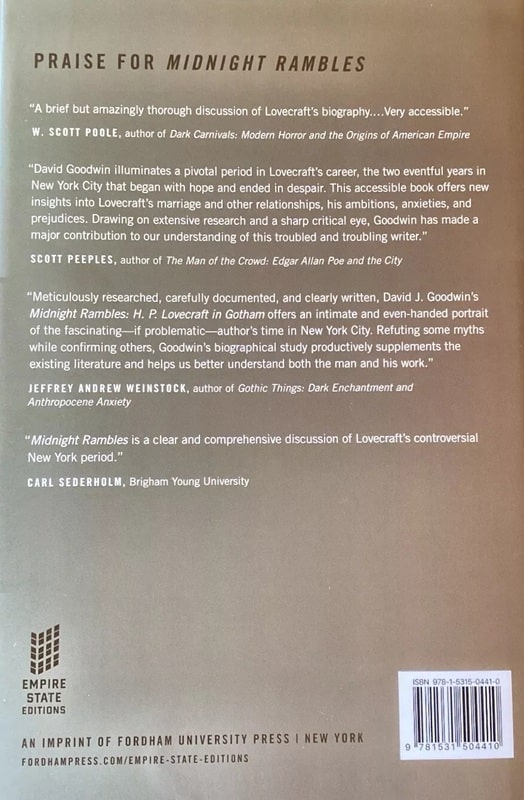
Midnight Rambles: H.P. Lovecraft in Gotham (Empire State Editions, November 7, 2023)
David J. Goodwin’s Midnight Rambles: H.P. Lovecraft in Gotham provides a narrow and deep slice of H. P. Lovecraft’s biography, detailing his personal and professional life during the few years he lived in New York City. Deeply researched and full of connections, Goodwin provides correction to some long-held Lovecraft biographical details and does not flinch from detailing Lovecraft’s innate hostility to non-WASP groups, ably describing it in the context of a deeply racist and anti-semitic society.
There are very few people who can claim to be expert on the life and work of H.P. Lovecraft, and Goodwin’s book puts him in range of that small number (such as S.T. Joshi). As he’s written and presented about Lovecraft more than half a dozen times, Goodwin seems poised to rise to stand among the critics named when the storied and controversial author rises in conversation, if he’s not there already. Learn more about Goodwin here.
Goodwin faces a difficult biographical subject in writer H.P. Lovecraft. Much material of signal importance during this time is unavailable. His spouse, Sonia Greene, destroyed some 400 of Lovecraft’s letters, largely from the period of interest for this text. Lovecraft’s aunts, demonstrably hostile to his marriage to Greene, discarded dozens of postcards when Lovecraft moved to New York through the simple expedient of giving away everything he had not specifically requested be sent to his new lodgings in the city. These details sample the rich trove of information about Lovecraft in Goodwin’s text.
Despite these holes in the biographical record, Goodwin’s ample research buttresses his assertions about the writer’s experiences in Gotham. The period constitutes a fertile time for Lovecraft, a locus that saw the invention of what would later be called the Cthulhu mythos. That it also saw the creation of the author’s least palatable, racist fiction represents an unavoidable truth. For each of the Lovecraft stories written during his residence in the city, Goodwin provides detailed research that helps illuminate the influences likely to have pressed upon the author. However, the biographer also includes historical demographic information to fully contextualize the lack of basis for any of Lovecraft’s many claims, a thread illustrating Lovecraft’s self-mythologizing nature.
The architecture of houses, the urban design of towns and cities was always of interest to Lovecraft, who, Goodwin explains, ambled extraordinary distances to view places and structures of interest. Readers familiar with John Crowley’s Little, Big may notice a reference to a real life builder important to New York that appears in that fictional text.
Lovecraft’s relationship with Sonia Greene merits several chapters and encapsulates their meeting, courtship, sudden marriage, and ultimate divorce that neatly marks the end of Lovecraft’s time in the city. Goodwin works wonders with the limited material available on this window to the past and readers familiar with Lovecraft biographies of broader scope will find material of interest in these pages. It is here Goodwin provides the price of admission for this text. Owing to an absence of a signed decree of divorce, past biographers have stated the author failed to sign those papers, meaning Greene’s subsequent marriage in California was bigamous.
Goodwin effectively implodes this “never signed” myth with solid evidence to the contrary, noting in addition that the loss of legal documentation was not uncommon in the 1920s. This conclusion is an exception among many assertions buttressed with the language of guesswork. Of all the guesses in Midnight Rambles, none struck this reviewer as unlikely or a reach. The biographer confines himself to likely scenarios, allowing for the many connections to form a compelling web to wrap these Lovecraft years for readers.
Readers interested in Lovecraft will find Midnight Rambles required reading. In this readable and at the same time admirably academic work (the two do not always meet amicably) even casual readers of Lovecraft may find information of interest. While Lovecraft expressed vehement racist and anti-semitic views, he married a Jew. While holding typical for the era dislike for homosexuals, one of his New York City walking buddies and long time correspondent was gay. Understanding this author, who some say serves as the pennant-waver for American horror fiction in sequence after Edgar Allan Poe, is made easier by Goodwin’s work. I recommend it to Lovecraft enthusiasts and any who find interest in the literary history of Gotham, our style and fashion capital.
Edward Carmien’s last article for Black Gate was When Your First Language is Role-Playing Games. His short stories “Before the Wind” and “Knives Under the Spring Moon” appeared in the print version on Black Gate in 2007 and 2008. He maintains a daily blog on writing at edwardcarmien.wordpress.com
Sorcery & Small Magics by Maiga Doocy
YA / Fantasy
Leovander Loveage is a bit of a failure as a scryer. While other sorcerers are writing powerful and complex spells he is stuck writing small magic. His exact opposite is the intensely serious Sebastian Grimm. He is a magical prodigy…and they hate each other.
Until they are forced to partner in class. Leovander hands Grimm a spell to cast on him but the small magic he thought was being cast was somehow mixed up with a powerful curse. And they must somehow put aside their differences to break the curse.
I try to not compare books but I’m going to here. Sorcery & Small Magics gave me some of the same feelings as Darkwood by Gabby Hutchinson Crouch. Honestly that’s about the highest praise I can think of. I loved this book and I’m excited for the series to continue.

A Sorceress Comes to Call - Book Review
 A Sorceress Comes to Callby T. Kingfisher
A Sorceress Comes to Callby T. KingfisherWhat is it about:A dark retelling of the Brothers Grimm's Goose Girl, rife with secrets, murder, and forbidden magic
Cordelia knows her mother is unusual. Their house doesn’t have any doors between rooms, and her mother doesn't allow Cordelia to have a single friend—unless you count Falada, her mother's beautiful white horse. The only time Cordelia feels truly free is on her daily rides with him. But more than simple eccentricity sets her mother apart. Other mothers don’t force their daughters to be silent and motionless for hours, sometimes days, on end. Other mothers aren’t sorcerers.
After a suspicious death in their small town, Cordelia’s mother insists they leave in the middle of the night, riding away on Falada’s sturdy back, leaving behind all Cordelia has ever known. They arrive at the remote country manor of a wealthy older man, the Squire, and his unwed sister, Hester. Cordelia’s mother intends to lure the Squire into marriage, and Cordelia knows this can only be bad news for the bumbling gentleman and his kind, intelligent sister.
Hester sees the way Cordelia shrinks away from her mother, how the young girl sits eerily still at dinner every night. Hester knows that to save her brother from bewitchment and to rescue the terrified Cordelia, she will have to face down a wicked witch of the worst kind.
What did I think of it:I've read several book by T. Kingfisher and loved them all. Still I kept mostly to her more horror-like books, with A Wizard's Guide to Defensive Baking the exception. I also had two more of her horror titles in my TBR when I received this book as a present. It had been on my radar (even had it in my greedy trotters when birthday shopping, but decided on another book), and the copy that I got was so pretty, and it had geese on the end-papers! So I immediately moved this to the top of TBR mountain.
And what a gorgeous, beautiful, amazing read!
This is a re-imagining of the faerie tale The Goose Girl. And it certainly has things that I recognize from the faerie tale, but mostly this is so much its own totally amazing story!
You get the story told from a couple of different viewpoints, mainly Cordelia and Hester.
I really liked Cordelia and felt for her. Her mother is a character I disliked and grew to hate the more I learned. I wanted Cordelia to find happiness.
I totally loved Hester! In her early 50's she has to deal with people thinking she's old, a bad knee, and her own insecurities. She also used to breed geese! I rooted for her even more than for Cordelia I can tell you.
(Voodoo Bride again wants me to add she really loved one of the male characters, and she says she wants a Richard of her own. Everyone needs someone like him in her opinion.)
There were several really cool other characters, and with how things were going I feared for a lot of them with good reason. This might be a retelling and not a horror story, there were enough bad things happening to keep me on edge.
After finishing this I had to take a breather before picking up my next book as I was still full of this one. You bet this will be reread and treasured! I will pick up one of the other Kingfisher books in my TBR soon.
Why should you read it:It's Absolutely Amazing!
Book Review: Grave Empire by Richard Swan
I received a review copy from the publisher. This does not affect the contents of my review and all opinions are my own.
Mogsy’s Rating: 4.5 of 5 stars
Genre: Fantasy
Series: Book 1 of The Great Silence
Publisher: Orbit (February 4, 2025)
Length: 529 pages
Author Information: Website
The Empire of the Wolf trilogy was one of the best and most compelling fantasy series I’ve read in years, so naturally I could not wait to get my hands on the next book by my newest favorite author Richard Swan. And with Grave Empire, Swan proves once more his talent in blending gripping storytelling with deep worldbuilding and complex political intrigue.
Though set in the same universe as the author’s previous series, this first volume of The Great Silence trilogy takes place many years later. So much time has passed that society in Sova has evolved onto the cusp of an industrial revolution, pushing the use of magic into the shadows. The world is changing, and with it, the balance of power is shifting. The story is told through the eyes of three main characters, each navigating their own path in this era of upheaval, unsure how their roles will shape the future.
First, we meet Renata, a junior ambassador to the mysterious mer-people of Stygia, whose routine is disrupted when her office is approached by two traveling monks from a death-magic sect, bringing dire warnings of the “Great Silence.” This is a prophecy that warns of an impending catastrophe—beginning with the inability to communicate with the spirits in the afterlife, signaling the end of the world. Realizing that this can have far-reaching consequences for all civilizations and not just the Sovans, Renata joins others on a diplomatic mission to seek guidance from the Stygion magic users, hoping to prevent the disaster from happening. Meanwhile, Peter is an inexperienced officer who receives a commission to lead a group of soldiers through wild and uncharted territory, which some even say is cursed. Stationed at the very edges of the empire, he and his troops face an unearthly enemy they are wholly unprepared for—one that invades the mind and makes you question everything you see or hear. And finally, we have Count Von Oldenburg, an ambitious and ruthless noble who harbors an obsession with anything to do with the arcane. With the reluctant help of his lover, he secretly conducts horrific experiments in his home involving dangerous and outlawed magic.
With the threat of apocalypse looming, our characters’ choices will determine whether the empire survives or falls. The main conflict of Grave Empire is the potential chaos the Great Silence could bring, though it does take a while for the connection between the three threads to be revealed. I found my time with each character compelling in their own way, each offering a unique perspective on events from their individual spheres of influence.
Renata’s chapters, for example, were steeped in political tension and diplomatic maneuvering, and she even survives an assassination attempt. In addition, there’s her personal struggle to gain respect in her role, one made all the more difficult by the near-mythological status of the mermen. Watching her journey unfold, from dealing with mockery to her eventual firsthand encounter with the merfolk, was one of the novel’s most rewarding aspects.
Peter, in contrast, is a very different kind or protagonist—one completely out of his depth who is attempting to lead a group of soldiers who neither respect or trust him. The letters to his father which precede each of his chapters reveal a scared young man filled with self-doubt. And when his unit finally comes face to face with the enemy, the results are grim, brutal, and disturbing.
Then there’s Von Oldenburg, who hears “grim, brutal, and disturbing” and says, “hold my beer.” In terms of page time, he had the least presence, yet his character had the most visceral impact. His twisted logic and relentless pursuit of knowledge make for an unsettling character study as he continually pushes ethical boundaries under the guise of scientific progress. His relationship with his mistress Yelena is another point of intrigue—complex, difficult to define, and layered with personal history which adds another fascinating level of depth to his chapters, even though he himself is a vile person.
Though reading the previous trilogy is not required, it was also exciting for me to see how the world has changed since the events at the end of Empire of the Wolf. We have moved into an industrial age where technological advancements reign supreme, and gunpowder appears to be the way of the future. However, the setting retains Swan’s signature mix of dark fantasy worlds populated by morally gray characters. Everything feels like they are in a state of flux, painting a picture of a society on the brink of transformation, being pulled in many different directions at once by love of tradition, hunger for power, and the fear of the unknown.
Swan’s prose is both atmospheric and accessible, which made it easy for me to immerse myself in Grave Empire. Written in the third person, we gained the ability to follow multiple characters across the empire, allowing us to explore more areas of Sovan society and beyond. Because of this, though, we do lose some of the intimacy of the first-person narrative, which was used for Empire of the Wolf. That might be my only regret here, as the three character POVs did not convey as much immediacy as I would have liked, and the connections between them were also not as apparent. The themes of the book are also very dark, without much levity, which made this a relatively slower, heavier read.
Nevertheless, by the end of the book, I was completely sold on its new plot conflicts and characters. The slow build ultimately pays off as the stakes rise become further entangled in the fate of the empire. Grave Empire is not going to be an easy or light read, but for fantasy fans who appreciate intricate storylines and deep character work, Richard Swarn delivers another stellar novel that is both thrilling and thought-provoking. With so many secrets still to unravel and mysteries to solve, I’m looking forward to seeing where the series goes next.
![]()
![]()
Goth Chick News: Throwback Thursday – When Mickey Rourke Met Lucifer
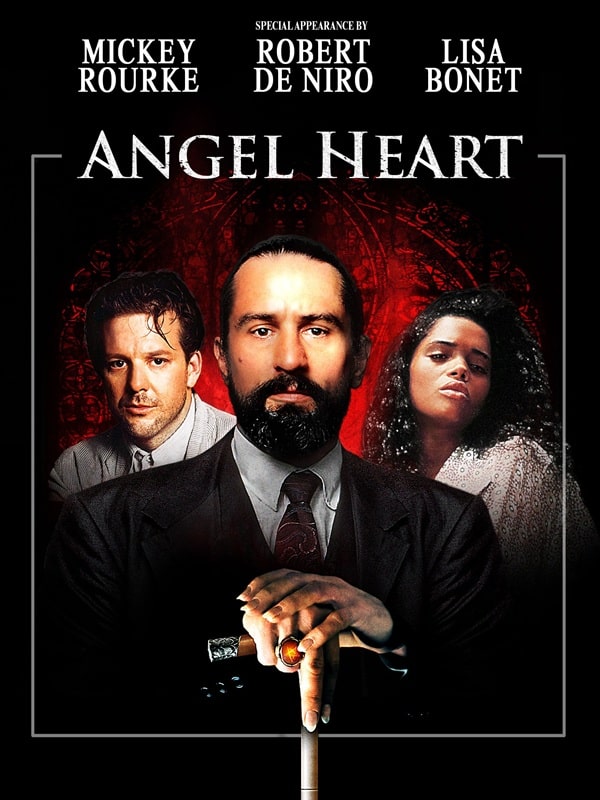 Angel Heart (Tri-Star Pictures, March 6, 1987)
Angel Heart (Tri-Star Pictures, March 6, 1987)
This is how my brain works sometimes.
This week Deadline reported that Robert De Niro will be starring in an upcoming crime drama for Netflix called The Whisper Man based on a novel by the same name. That made me think that when I last saw De Niro, the dude looked pretty old, and that starring in a multi-installment series for Netflix would be pretty taxing. That led me to IMDB to find out how old he really is (De Niro is 81), which resulted in going down the rabbit hole of his incredible career, which led me to Angel Heart (1987).
I had all but forgotten about this film, but the minute I read the name all this controversial stuff about it started resurfacing in my mind. Honestly, I couldn’t recall if Angel Heart was really all that controversial, or if I remembered it wrong and naturally this resulted in a lost afternoon reading everything about it I could get my hands on.
So, here we are and yes, the movie was steeped in controversy.
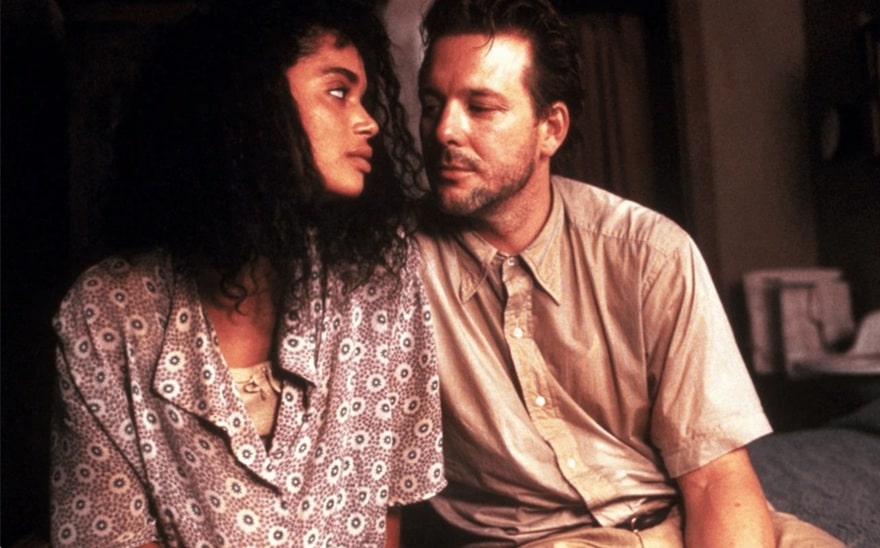 Mickey Rourke and Lisa Bonet in Angel Heart
Mickey Rourke and Lisa Bonet in Angel Heart
Directed by Alan Parker (Midnight Express) and starring the pre-cosmetic surgery hotness that was a young Mickey Rourke, Robert De Niro, and Lisa Bonet (one of those adorable Cosby Show kids), Angel Heart blended the genres of psychological thriller, neo-noir, and horror. Set in 1955 New Orleans, it tells the story of small-time private investigator Harry Angel (Rourke) who is hired by a man who calls himself Louis Cypher (De Niro) to track down a singer named Johnny Favorite.
The investigation takes Angel into the backwaters of the Louisiana bayou where he meets the luscious young Epiphany Proudfoot (Bonet), who also happens to be a voodoo priestess. Suddenly, the trail Angel is following becomes soaked in blood and gruesome murder. So, who is trying to keep Angel from finding his quarry?
To kick off the reasons Angel Heart became a cult classic, after it pretty much bombed at the box office, was that at the time Bonet was best known for her role as Denise Huxtable on The Cosby Show, a wholesome family sitcom. Bonet’s Angel Heart performance included a graphic sex scene and nudity, which led to backlash for her career and to her public image.
Though it didn’t exactly ruin her in Hollywood, Angel Heart made it challenging for Bonet to find roles that matched her previous success. Producers and casting agents often pigeonhole actresses based on public perception, and Bonet’s decision to take on such a provocative role led to her being seen as “too edgy” for mainstream projects (for another example, seee Elizabeth Berkley [Saved by the Bell] and her movie Showgirl [1995]).
While we’re on the topic of sex scenes, the most infamous Angel Heart controversy involved the raw sex scene between Rourke and Bonet. This scene, which featured nudity, blood, and disturbing imagery, pushed boundaries for its time, not the least of which was because of the revelation of an incestuous relationship between Rourke’s and Bonet’s characters. This plot twist, coupled with the explicitness of the scene, sparked outrage and made the film even more polarizing.
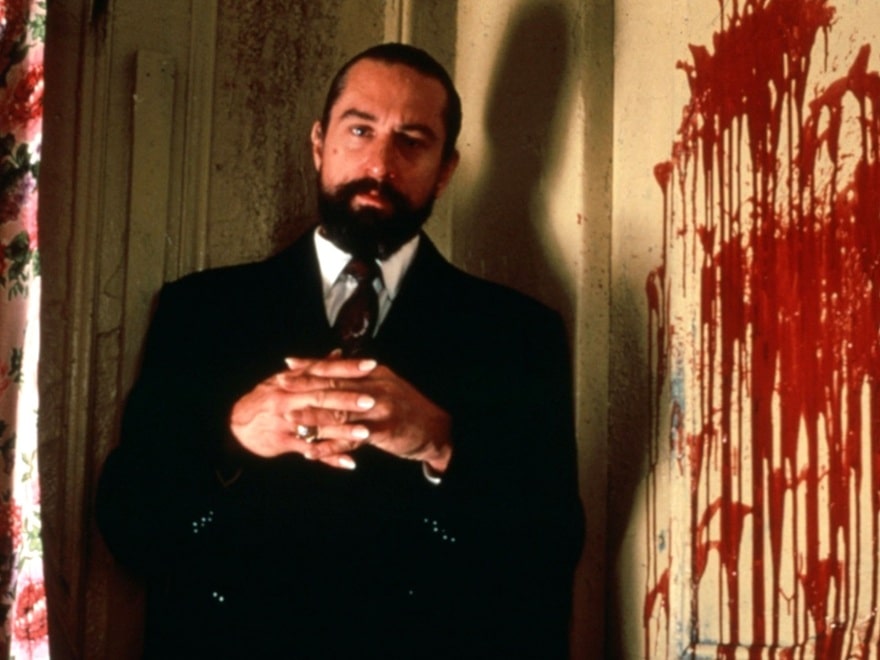 Robert De Niro as Louis Cyphre
Robert De Niro as Louis Cyphre
The film’s depiction of voodoo practices, combined with De Niro’s portrayal of Louis Cyphre (an alias for Lucifer if that hasn’t jumped out at you yet), upset religious groups to no end. De Niro’s performance, though praised by audiences for its eerie subtlety, drew vocal criticism for allegedly glamorizing the devil. Critics accused Angel Heart of promoting occultism and blasphemy, while others argued that the film perpetuated stereotypes about voodoo and Haitian culture, painting them as sinister or evil.
Then there was the violence. Angel Heart is graphically violent, with several brutal and unsettling death scenes, including one involving a character’s heart being ripped out and another being boiled alive in a large vat of jambalaya. The overall dark tones and the depiction of psychological torment left many viewers disturbed, especially as Harry Angel’s true identity and fate are revealed.
The Motion Picture Association of America (MPAA) initially gave the film an X rating. Alan Parker had to cut approximately 10 seconds of footage from Bonet and Rourke’s nude romp to secure an R rating, though many still found the final version shocking. Ironically all the goriest scenes remained intact. You’d never imagine De Niro eating a hard-boiled egg could be so unnerving.
 Mickey Rourke then and now
Mickey Rourke then and now
Yes, I immediately had to give Angel Heart a rewatch – it’s pretty much streaming everywhere. Frankly, I’ve always liked it in the same way I’ve always liked The Ninth Gate (1999) with Johnny Depp. Just suspend your disbelief and go there, provided you can get around the distraction of how the actors have changed (not just aged) in the years since.
Spotlight on Enthralling “Once Was Willem” by M. R. Carey
Mark your calendars, LitStackers! Once Was Willem by M. R. Carey is in presale (the…
The post Spotlight on Enthralling “Once Was Willem” by M. R. Carey appeared first on LitStack.
On McPig's Wishlist - Paladin's Grace
 Paladin's Grace (The Saint of Steel #1)by T. Kingfisher
Paladin's Grace (The Saint of Steel #1)by T. KingfisherStephen's god died on the longest day of the year…
Three years later, Stephen is a broken paladin, living only for the chance to be useful before he dies. But all that changes when he encounters a fugitive named Grace in an alley and witnesses an assassination attempt gone wrong. Now the pair must navigate a web of treachery, beset on all sides by spies and poisoners, while a cryptic killer stalks one step behind…
From the Hugo and Nebula Award winning author of Swordheart and The Twisted Ones comes a saga of murder, magic, and love on the far side of despair.


Recent comments